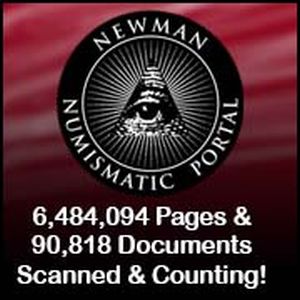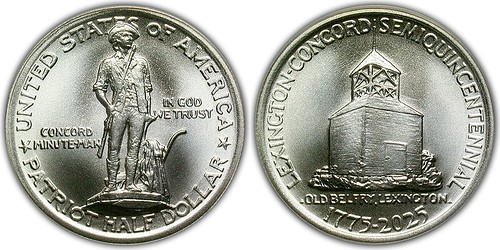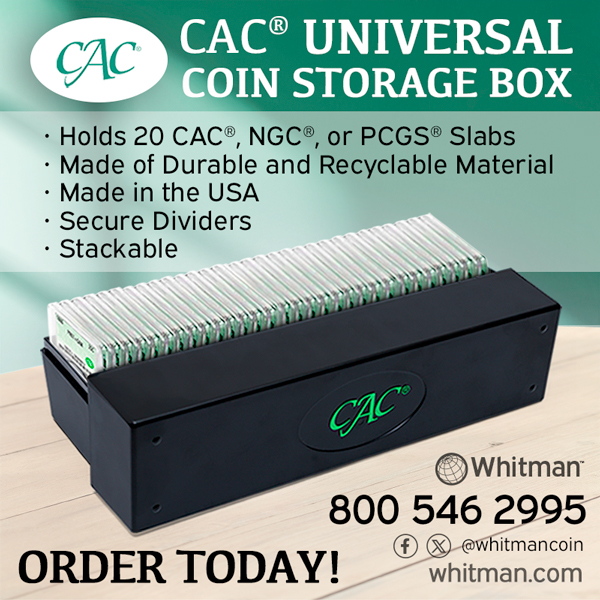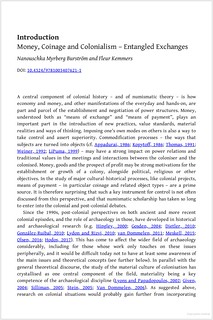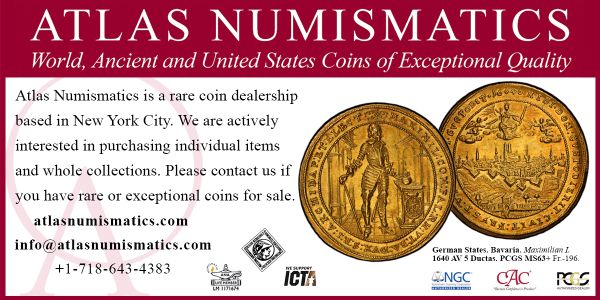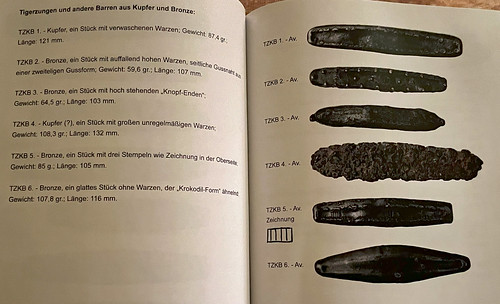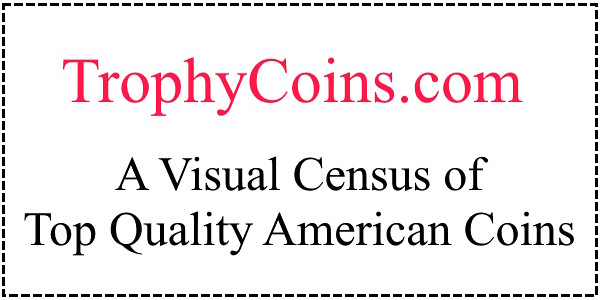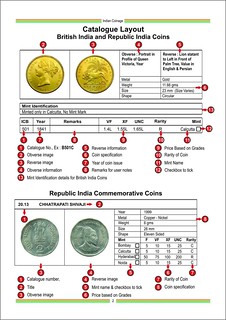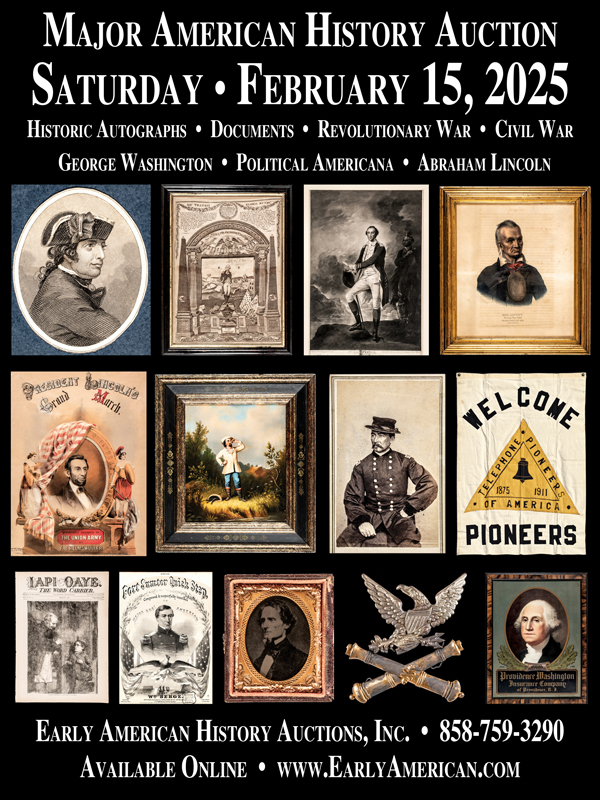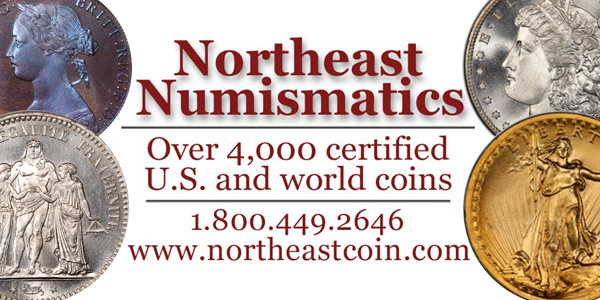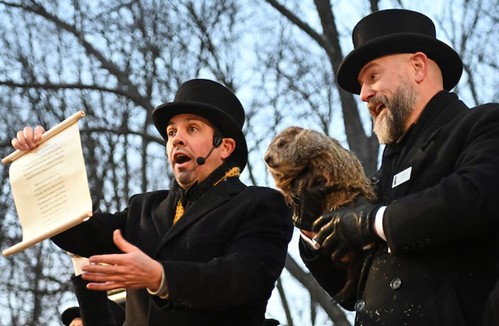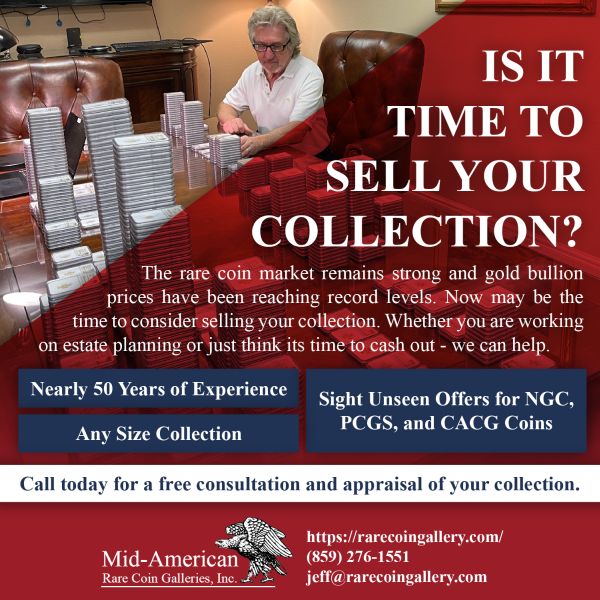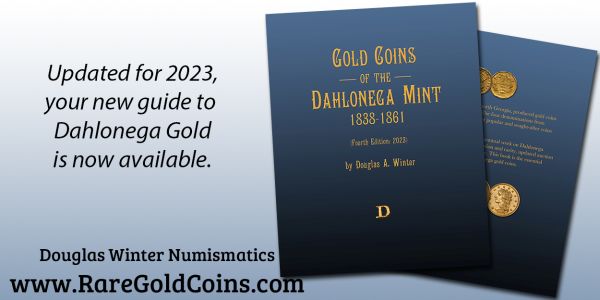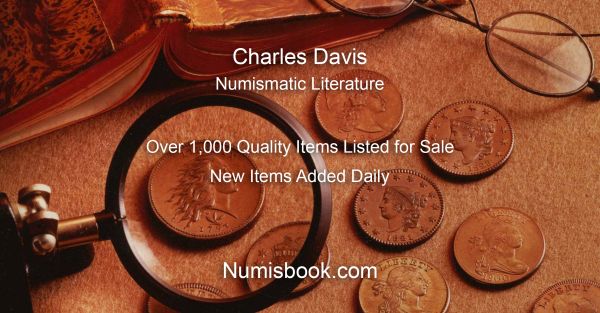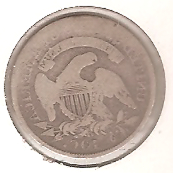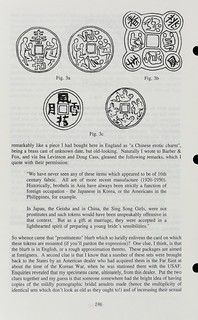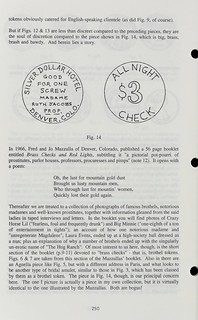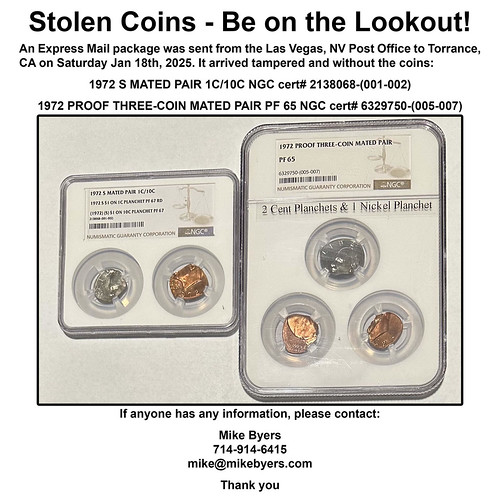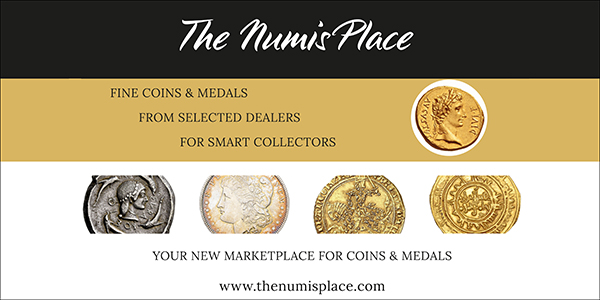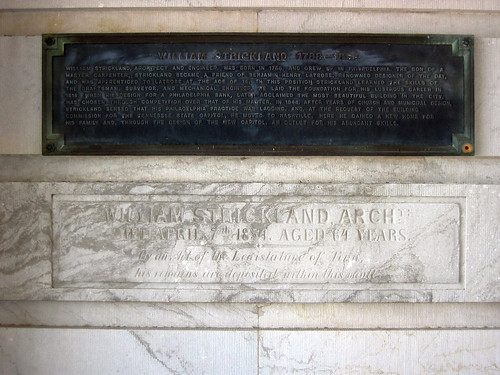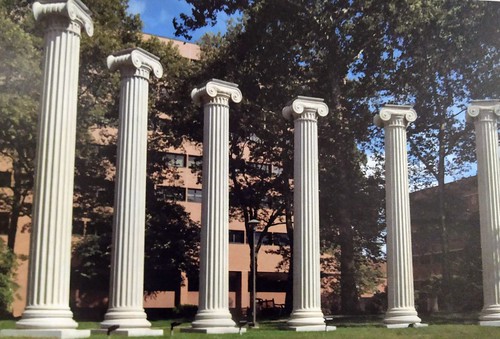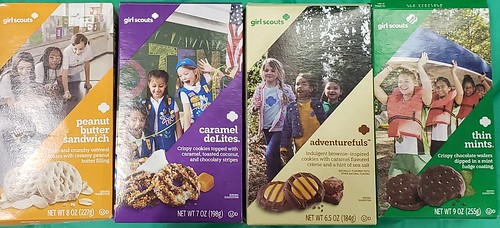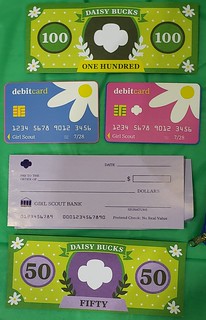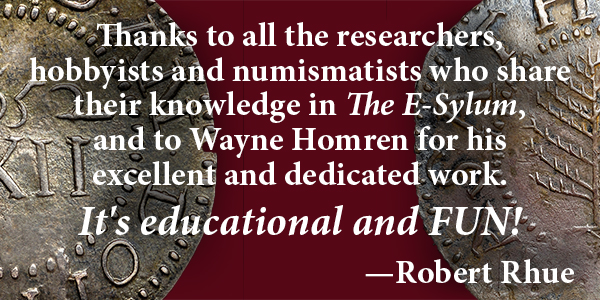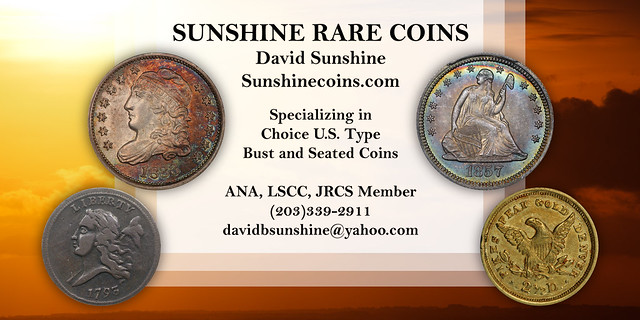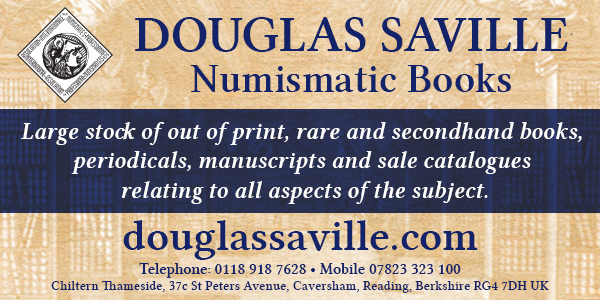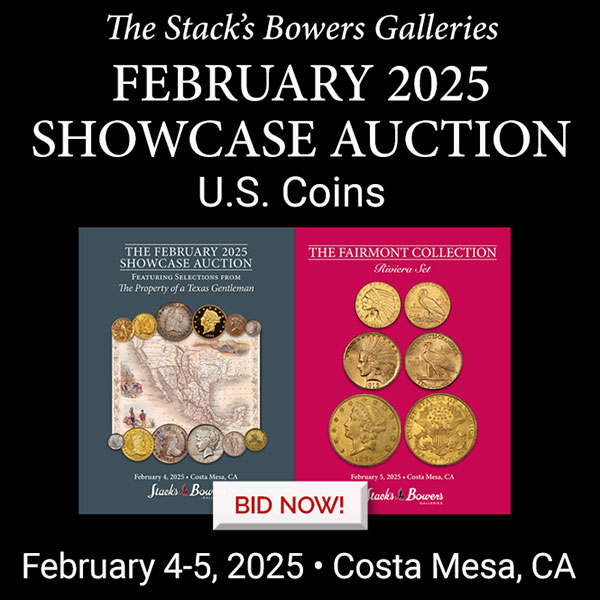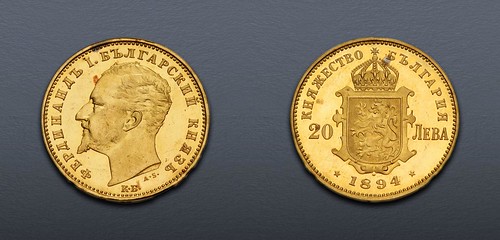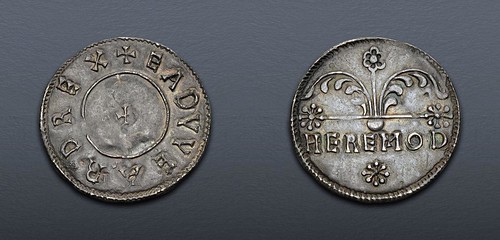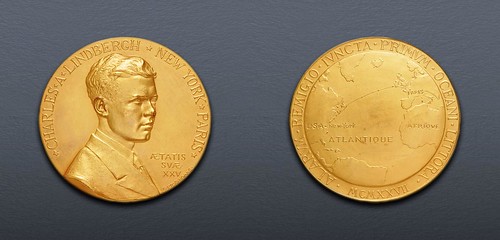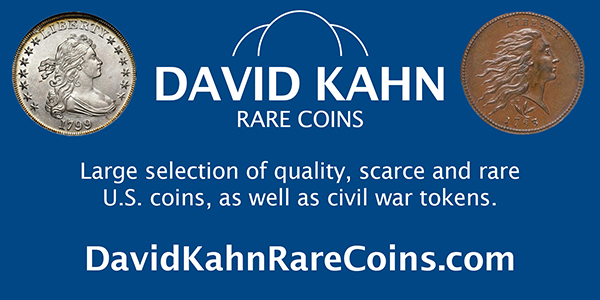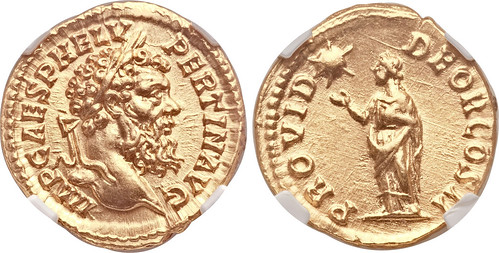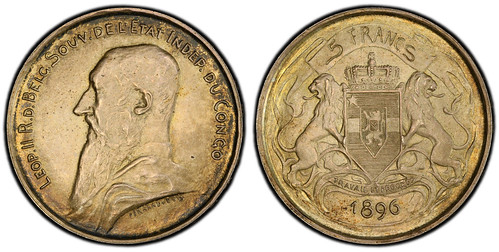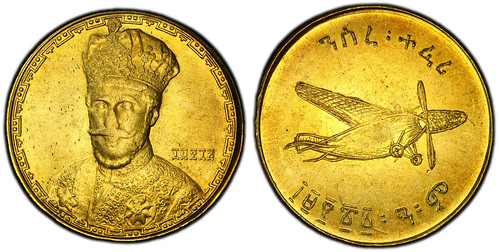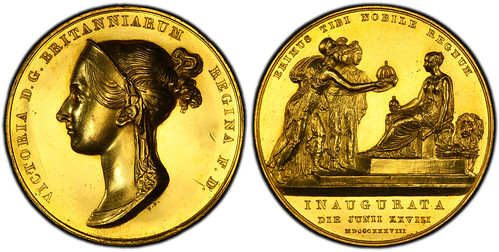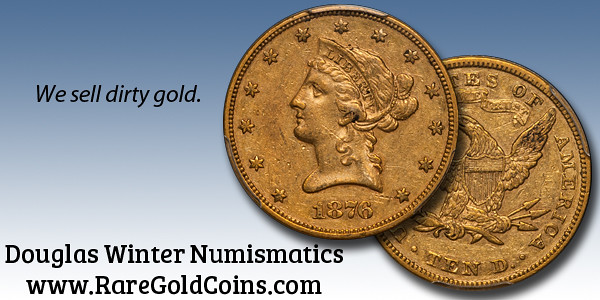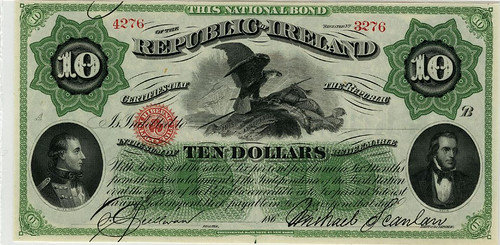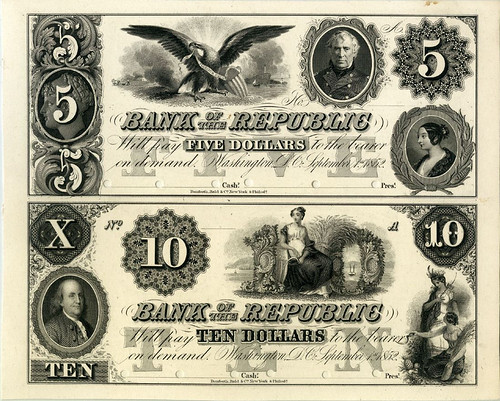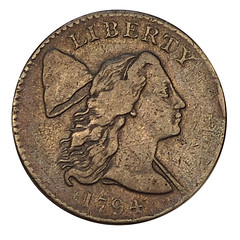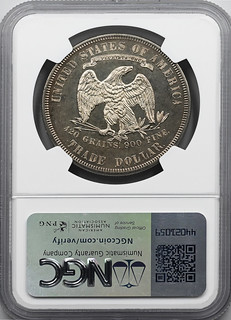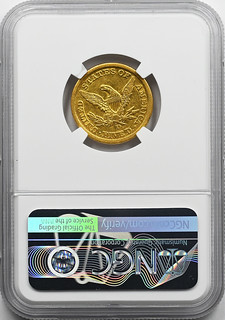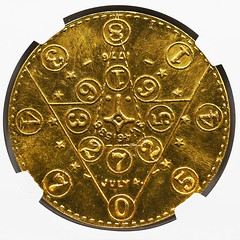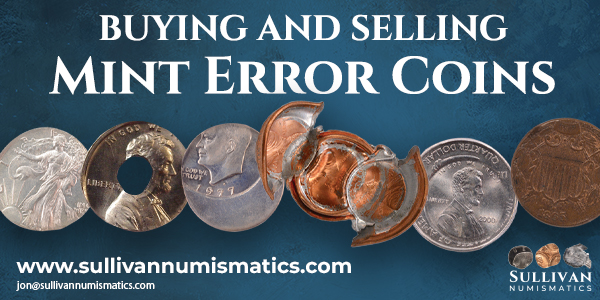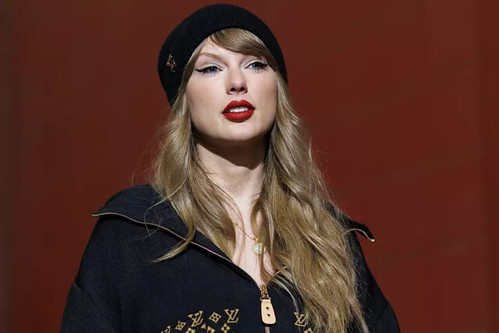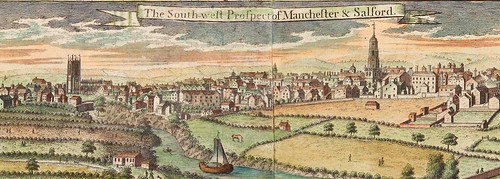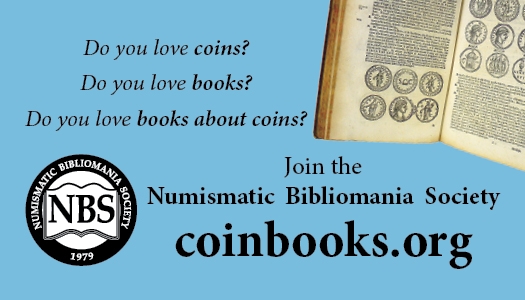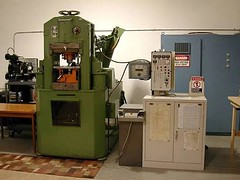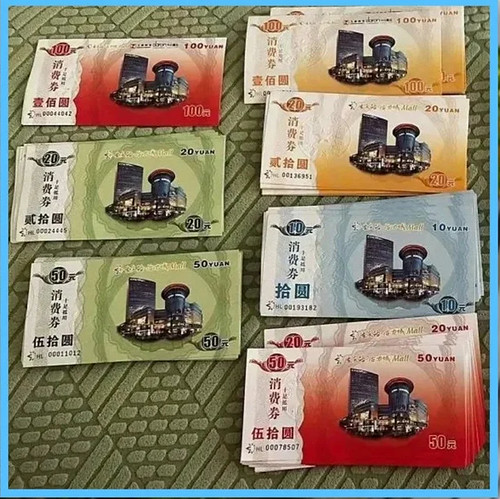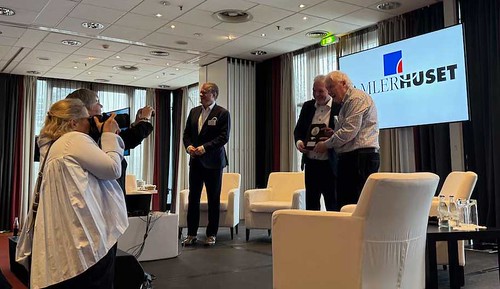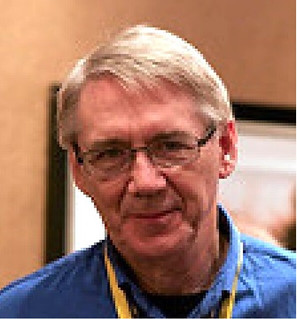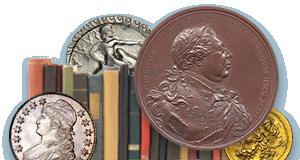
Visit our NBS Sponsors
About UsThe Numismatic Bibliomania Society is a non-profit association devoted to the study and enjoyment of numismatic literature. For more information please see our web site at coinbooks.org SubscriptionsThose wishing to become new E-Sylum subscribers (or wishing to Unsubscribe) can go to the following web page link MembershipThere is a membership application available on the web site Membership Application To join, print the application and return it with your check to the address printed on the application. Print/Digital membership is $40 to addresses in the U.S., and $60 elsewhere. A digital-only membership is available for $25. For those without web access, write to: Jeff Dickerson, Treasurer AsylumFor Asylum mailing address changes and other membership questions, contact Jeff at this email address: treasurer@coinbooks.org SubmissionsTo submit items for publication in The E-Sylum, write to the Editor at this address: whomren@gmail.com BUY THE BOOK BEFORE THE COINSale CalendarWatch here for updates! |
- WAYNE'S WORDS: THE E-SYLUM FEBRUARY 2, 2025
- BENJAMIN WEST BRITISH COIN LETTER OFFERED
- NEW BOOK: MONEY, COINAGE AND COLONIALISM
- NEW BOOK: GELD AUS DEM NORDEN
- NEW BOOK: INDIAN COINAGE 10TH EDITION
- VALE MERRILL GIBSON (1952-2024)
- DAVID MICHAEL SMOCK (1984-2025)
- NUMISMATICS OF PUNXSUTAWNEY
- VIDEO: CANADIAN DOLLARS: AN INTRODUCTION
- ROMAN COINS OF EGYPT PRESENTATION
- OLDEST COINS FOUND IN CHANGE
- NOTES FROM E-SYLUM READERS: FEBRUARY 2, 2025
- 2025 LEXINGTON-CONCORD COMMEMORATIVE
- THE TOMB OF WILLIAM STRICKLAND
- GIRL SCOUTS USA DAISY DOLLARS
- VOCABULARY TERM: REEDED EDGE, REEDING
- THE ALAN KESSLER MYSTERY
- 2025 ANS TRUSTEES' AWARD TO THE NYINC
- GERRY FORTIN INTERVIEW, PART FIVE
- CNG TRITON XXVIII AUCTION RESULTS
- ATLAS NUMISMATICS SELECTIONS: FEBRUARY 2, 2025
- ARCHIVES INTERNATIONAL AUCTION 99 SELECTIONS
- NUMISMATIC AUCTIONS LLC SALE 69
- TAYLOR SWIFT'S ANCIENT COIN NECKLACE
- 1793 MANCHESTER PROMISSORY HALFPENNY, PART TWO
- COLLECTABLE COUNTERFEIT COINS, PART TWO
- IRAN CONSIDERING CURRENCY REVALUATION
- NORTH KOREAN REVALUATION RUMORED
- CHINESE COMPANY PAYS EMPLOYEES IN SCRIP
- LOOSE CHANGE: FEBRUARY 2, 2025
- FEATURED WEBSITE: THE PAPER MONEY PROJECT
- ABOUT THIS ISSUE: FEBRUARY 2, 2025
Content presented in The E-Sylum is not necessarily researched or independently fact-checked, and views expressed do not necessarily represent those of the Numismatic Bibliomania Society.
WAYNE'S WORDS: THE E-SYLUM FEBRUARY 2, 2025
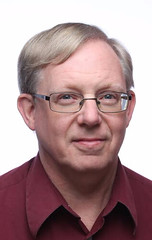 New subscribers this week include:
Larry Hanks, courtesy of Bob Steinberg;
Daniel Salinero of Indio, California; and
Mike Byers.
Welcome aboard! We now have 7,254 subscribers.
New subscribers this week include:
Larry Hanks, courtesy of Bob Steinberg;
Daniel Salinero of Indio, California; and
Mike Byers.
Welcome aboard! We now have 7,254 subscribers.
Thank you for reading The E-Sylum. If you enjoy it, please send me the email addresses of friends you think may enjoy it as well and I'll send them a subscription. Contact me at whomren@gmail.com anytime regarding your subscription, or questions, comments or suggestions about our content.
This week we open with an interesting 1798 letter from American artist Benjamin West, three new books, two obituaries, updates from the Newman Numismatic Portal, notes from readers, and more.
Other topics this week include Indian coinage, Canadian dollars, the Roman coins of Egypt, old coins found in change, an unofficial semiquincentennial half dollar, Daisy Dollars, fixed price and auction highlights, Taylor Swift's ancient coin necklace, currency revaluations, and The Paper Money Project.
To learn more about coinage and colonialism, the primitive money of Myanmar, the National Bank Notes of Punxsutawney, PA., the tomb of William Strickland, reeded edges, knurls and flutes, Alan Kessler, the Fenian Brotherhood, Manfred Dunker, and the Numerology Masonic Prophetic Magic Square Knights Templar Themed Medal, read on. Have a great week, everyone!
Wayne Homren
Editor, The E-Sylum
BENJAMIN WEST BRITISH COIN LETTER OFFERED
The William Reese Company is offering an interesting 1798 letter from American artist Benjamin West about his drawings for British coin designs. Mitch Fraas alerted us to this item back in December 2021. It's still available; I came across it again this week and thought we should have another look at it. -Editor
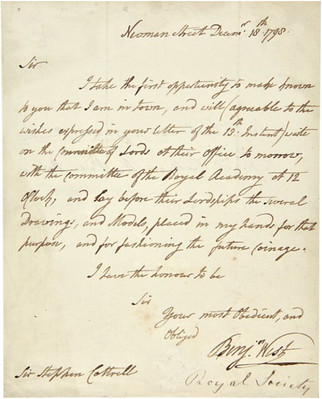 An interesting letter from the great American-born artist, Benjamin West, regarding drawings and models created for British coins. Benjamin West (1738-1820) was born in Springfield, Pennsylvania, and studied art in America and Italy before moving to England permanently in 1763. West was a founder of the Royal Academy and its second president (following Sir Joshua Reynolds, and serving in that capacity from 1792 until his death), became "History Painter to the King" in 1772, and was commissioned by George III to execute some sixty paintings between 1768 and 1801. The text of the letter reads:
An interesting letter from the great American-born artist, Benjamin West, regarding drawings and models created for British coins. Benjamin West (1738-1820) was born in Springfield, Pennsylvania, and studied art in America and Italy before moving to England permanently in 1763. West was a founder of the Royal Academy and its second president (following Sir Joshua Reynolds, and serving in that capacity from 1792 until his death), became "History Painter to the King" in 1772, and was commissioned by George III to execute some sixty paintings between 1768 and 1801. The text of the letter reads:
"Sir, I take the first opportunity to make known to you that I am in town, and will (agreeable to the wishes expressed in your letter of the 13th instant) wait on the committee of Lords at their office tomorrow, with the committee of the Royal Academy at 12 o'clock, and lay before their Lordships the several drawings, and models, placed in my hands for that purpose, and for fashioning the future coinage. I have the honour to be, sir, your most obedient, and obliged Benj. West."
Not much is known of Sir Stephen Cottrell, but he appears to have been a member of the British Board of Trade and also involved in British naval and commercial affairs, especially English fishing interests in Newfoundland, later in his life. Manuscript letters from Benjamin West are rare.
Description
[1]p. Quarto. Old folds. Slightly later two-line note on verso. Two tiny holes in upper blank margin, not affecting text. Fine.
A very interesting early American cross-Atlantic coinage collaboration. Do any of our readers have more background on this exchange? Do West's drawings still exist? -Editor
To read the complete lot description, see:
[AUTOGRAPH LETTER, SIGNED, FROM PAINTER BENJAMIN WEST TO SIR STEPHEN COTTRELL, REGARDING A MEETING WITH A COMMITTEE OF LORDS AND MEMBERS OF THE ROYAL ACADEMY TO REVIEW DRAWINGS AND MODELS FOR BRITISH ...
(https://www.williamreesecompany.com/autograph-letter-signed-from-painter-benjamin-west-to-sir-stephen-cottrell-regarding-a-meeting-with-a-committee-of-lords-and-members-of-the-royal-academy-to-review-drawings-and-models-for-british-37197.html)
To read the earlier E-Sylum article, see:
https://www.coinbooks.org/v24/esylum_v24n51a12.html
(https://www.coinbooks.org/v24/esylum_v24n51a12.html)
NEW BOOK: MONEY, COINAGE AND COLONIALISM
Nanouschka Myrberg Burström and Fleur Kemmers has written a new book on how money affected the relations between colonizer and colonized, published by Routledge. Here's some information and sample pages. -Garrett
Money, Coinage and Colonialism
Nanouschka Myrberg Burström (Editor)
Fleur Kemmers (Editor)
Routledge (Publisher)
Description
 This book explores coinage and related object types as an important form of material culture that is crucial to interrogating interactions between coloniser and colonised.
This book explores coinage and related object types as an important form of material culture that is crucial to interrogating interactions between coloniser and colonised.
Money, Coinage and Colonialism is a much overdue treatment of coinage and money in debates around ancient and recent colonial practices. It argues that coinage offers unique opportunities to study interactions and effects of the meeting between colonisers and colonised, as well as the economic, political and ideological interactions between colonial communities and the state of origin. It is argued that the study of coins and other means of exchange may reveal less apparent and under-communicated processes, values and discourses in the study of colonial environments and projects, with commonalities informing a larger "global history" approach. A broad picture is built from numerous case studies, spanning from Classical Greek colonies to European colonial enterprises of the Modern period, exploring colonial histories, settings, ideology and resistance. Particular attention is paid to the role of coins in identity construction; to ambiguity, hybridity and creolisation of monetary objects in colonial contexts; and to specific uses of coins that tell of violence, oppression and resistance as well as of networks, acculturation and globalisation.
Composed of chronologically broad and diverse case studies from colonial contexts, this book is for researchers in colonial and post-colonial archaeology as well as archaeological and cultural-historical numismatics.
Critic's Reviews
"Money, Coinage and Colonialism demonstrates how the study of material forms of money can reveal often contradictory forms of adaptation, negotiation and identity construction during colonial cultural interactions. The authors explore a stimulating selection of global contexts, ranging from 600 BCE to the twentieth century."
Christopher Howgego, Professor, University of Oxford and Research Keeper, Ashmolean Museum
"An invaluable collection revealing how money and coinage were powerful players in both prehistoric and historic colonial encounters. Linking material and immaterial spheres, Money, Coinage and Colonialism offers novel insights from around the world into the mechanisms, values and discourses at the heart of colonial projects. Whether enforced or developed through on-site negotiations, the authors ably demonstrate how currencies form a vital part of global history and cultural heritage. A must-read contribution for scholars working across archaeology, material culture and colonial history."
Lynn Meskell, Penn Integrates Knowledge (PIK) Professor, Department of Anthropology, School of Arts & Sciences, Penn Museum, and Weitzman School of Design, University of Pennsylvania
"This is a path-breaking book that establishes the centrality of control of money and the economy to the colonial project. Its appeal lies in the rich and diverse range of interdisciplinary case studies that cut across chronological and geographic boundaries."
Himanshu Prabha Ray, Fellow, Oxford Centre for Hindu Studies
"From the first millennium BCE to the twentieth century, the arrival of colonialism has often meant the arrival of money. However, this is seldom examined as a cultural phenomenon by archaeologists and has been virtually absent in postcolonial discussions. The present book redresses this situation by showing the relevance of currency and its materiality in understanding colonial ideologies, identities and processes of cultural hybridisation. The volume, global in scope, shows through a diversity of thought-provoking case studies that the introduction of money has never been straightforward, but always subject to negotiations, appropriations and resistance. This is a must-read for anybody interested in the history and archaeology of colonialism, as well as in theoretically informed approaches to numismatics."
Alfredo González-Ruibal, Researcher, Institute of Heritage Sciences, Spanish National Research Council
Found via the Winter 2024 issue of the Journal of the Oriental Numismatic Society -Editor
For more information, or to order, see:
Money, Coinage and Colonialism
(https://www.routledge.com/Money-Coinage-and-Colonialism-Entangled-Exchanges/Burstrom-Kemmers/p/book/9781032526386)
NEW BOOK: GELD AUS DEM NORDEN
The January 2025 International Primitive Money Society Newsletter had a short article about a new book on the primitive money of Myanmar, north Thailand and Laos. With permission we're republishing it here. Images courtesy Editor Bob Leonard. Thank you. -Editor
 Hans Menzel-Severing has self-published a fine study of
the primitive money of Myanmar, north Thailand and
Laos (Shan states and Lannatai), Geld aus dem Norden,
(hardbound, 209 p., illustrated in color throughout,
German text [easy to follow], 2024), apparently based on
his own outstanding collection. No price stated and not
available from the usual U.S. sources, but he will be glad
to quote price and shipping.
Hans Menzel-Severing has self-published a fine study of
the primitive money of Myanmar, north Thailand and
Laos (Shan states and Lannatai), Geld aus dem Norden,
(hardbound, 209 p., illustrated in color throughout,
German text [easy to follow], 2024), apparently based on
his own outstanding collection. No price stated and not
available from the usual U.S. sources, but he will be glad
to quote price and shipping.
This study covers various forms of circular silver ingots (flower money, toks, pig-mouths, and leaf-money) plus an exhaustive catalog of cigar- shaped ingots. Ten pages are devoted to the so-called leech-money of Luang Prabang, 1353-1571 (?), with its stamps.
Other forms of bar money, such as "Fish-Money" and tiger tongues follow. Next is a section on Ka-K'im and bracelet coins, Chiengsaen bars, and trade dollars (including chopmarks). The frontispiece is a map of related sites.
Unfortunately, the author did not provide an email address, but he can be reached at
Hans Menzel-Severing
Pfarrer-Martini-Strasse 39
53121 Bonn, Germany
-Editor
NEW BOOK: INDIAN COINAGE 10TH EDITION
A new edition of the Indian coinage book by Sainath Reddappa has been published. Also found via the Winter 2024 issue of the Journal of the Oriental Numismatic Society. Here's information from the publisher's website. -Editor
 Indian Coinage 2023-24 British India Portuguese India Republic India (1835-2024) 10th Edition
Indian Coinage 2023-24 British India Portuguese India Republic India (1835-2024) 10th Edition
By Sainath Reddappa
Hard Back/ Full Color/ISBN : 978-93-340-7242-6/ M.R.P ?999.00 / $45
About the book
Indian Coinage British India – Portuguese India – Republic India (1835 – 2024), 10th Edition, is a complete guidebook cum Checklist for Numismatist. This edition is updated up to date and enhanced version of former editions. This book is drafted to be a supporting guide to numismatist in identifying rare coins and its average market value. Keen study has been made by surveying and interacting with various coin sellers and numismatists from different parts of the country.
Book system
This book is classified into three major Parts, British India, Portuguese India & Republic India coins. British India Coins comprises coins issued by the British, during their rule in India between 1835 and 1947. This part illustrates coins of various denominations issued under British Rule. Portuguese India coins comprise of coins issued between 1871 – 1961 (Machine Struck). Republic India comprises of coins issued by the Government of India after India became Republic. This book catalogs Republic India Coins from 1950 to 2024. Republic India coinage is further classified into Commemorative Issue, Uncirculated Sets, Proof Sets, Uncirculated Regular Issue & Proof Set Regular Issue.
About the Author
 Sainath Reddappa, the author of "Indian Coinage: British India – Portuguese India – Republic India (1835 – 2023)" is a well-known in the numismatic community. He holds a postgraduate degree in Information Technology and is an entrepreneur by profession. However, his true passion lies in collecting Indian coins. He has been a curious collector since 2004 and has developed a deep knowledge of Indian coinage, from ancient to modern coins.
Sainath Reddappa, the author of "Indian Coinage: British India – Portuguese India – Republic India (1835 – 2023)" is a well-known in the numismatic community. He holds a postgraduate degree in Information Technology and is an entrepreneur by profession. However, his true passion lies in collecting Indian coins. He has been a curious collector since 2004 and has developed a deep knowledge of Indian coinage, from ancient to modern coins.
The first edition of "Indian Coinage" was published in 2011 and received a tremendous response from the numismatic community. It quickly became a bestseller among numismatists and established Sainath Reddappa as a respected authority on Indian coinage. The book's popularity led to several subsequent editions, with the most recent being the 9th edition, which is updated up to 2023.
Throughout the book, Sainath Reddappa's expertise and passion for Indian coinage shines through. His thorough research and detailed information make the book an invaluable resource for numismatists. The book's organization and easy-to-understand language make it accessible to both beginners and experienced collectors.
His other book of similar interest is "Indian Banknotes: British India, Portuguese India, French India and Republic India", its a comprehensive guide to the banknotes of India, covering banknotes of British India, Portuguese India, French India and independent & Republic India. Sainath Reddappa is not only a respected authority on Indian coinage, but also has a passion for photography and Indian temple art and architecture. He has captured several monuments and has published several books on these subjects.
For more information, or to order, see:
Indian Coinage 2023-24
(https://indiancoinage.in/)
VALE MERRILL GIBSON (1952-2024)
The Ancient Coin Club of Los Angeles announced the passing of former President Merrill Gibson. Thanks to Mike Markowitz for sending this along. -Editor
 With great sadness, we report that long time Ancient Coin Club of Los Angeles member Merrill Gibson passed away from cancer on December 21, 2024 - just two months shy of his 72nd birthday.
With great sadness, we report that long time Ancient Coin Club of Los Angeles member Merrill Gibson passed away from cancer on December 21, 2024 - just two months shy of his 72nd birthday.
Merrill was born in Los Alamos, New Mexico (his father worked at the Los Alamos National Laboratory) and was raised there with his sister Dianna. Merrill went on to gain an engineering degree from Cal Tech. He worked in a variety of employments including working as a mortgage broker and designing web pages prior to settling down with Apollo Numismatics.
Merrill joined the Club at the February 11, 2004 meeting and remained active until the end. He served for 16 years on the ACCLA Board of Directors (2006-2021). For two of those years (2013 and 2014) he served as Club President.
In May 2005, Merrill opened "Apollo Numismatics" on Vcoins; a store specializing in high grade Greek, Roman, and Celtic coins. Merrill was a serious photographer and aimed for all his coins to be well photographed. He worked tirelessly to present large, sharply focused, well-lit photographs of his coins. He happily shared some of his tips on coin photography at our September 2016 coin photography seminar.
Merrill described himself as "completely captivated by the many attractions of ancient coins." He wrote, "Ancient coins were the creations of people who in many ways thought very differently than we do today, yet who nonetheless beat the path that our civilization now treads. People today share with the ancients of the classical world a basic humanity, often expressed with brutal honesty in ancient coin designs. ... Ancient coins were monetary vehicles, but they were also communication devices, and they serve that function still, informing and educating us about the world they were a part of, the people who touched them daily, and their creators - certainly one of the appeals of ancient coinage is the amazement evoked by an understanding of the technical skill and artistic insight of the ancient celators."
As one of his many Club activities, in 2015 Merrill organized and participated in a four-part introductory ancient coin seminar. This seminar was held June 4, 2015 at the Long Beach Coin Expo. Videos of the talks, including his talk Ancient Coin Collecting v. U.S. and World Collecting - Differences and Similarities, are available on the Club website.
Merrill will be sorely missed. Our sympathy and condolences go out to his sister Dianna and to his many friends in the Club and elsewhere.
For more information on the Ancient Coin Club of Los Angeles, see:
https://www.accla.org/
DAVID MICHAEL SMOCK (1984-2025)
ANA District Representative, author, and Money Talks presenter David Smock recently passed away. -Garrett
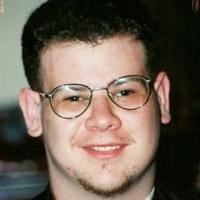 David Michael Smock, 40, of Jonesboro passed away Friday, January 17, 2025, at his home in Jonesboro. Born in 1984 in Jonesboro, David lived a life marked by creativity, determination, and love for those around him. David attended Annandale High School in Annandale, Virginia, where he was an active member of the Student Government Association and graduated at Constitution Hall in Washington, D.C. He went on to study at Arkansas State University-Newport where he continued his involvement in student government. He also attended Lyon College in Batesville. David was deeply engaged in his community and served as a canvasser for Chad Causey during his Arkansas Congressional campaign.
David Michael Smock, 40, of Jonesboro passed away Friday, January 17, 2025, at his home in Jonesboro. Born in 1984 in Jonesboro, David lived a life marked by creativity, determination, and love for those around him. David attended Annandale High School in Annandale, Virginia, where he was an active member of the Student Government Association and graduated at Constitution Hall in Washington, D.C. He went on to study at Arkansas State University-Newport where he continued his involvement in student government. He also attended Lyon College in Batesville. David was deeply engaged in his community and served as a canvasser for Chad Causey during his Arkansas Congressional campaign.
A passionate and award-winning coin collector, David received numerous accolades for his collection and wrote articles for prominent professional publications including Coin World, The Numismatist, and Numismatic News. Beyond his interest in numismatics, David was a talented visual artist, woodcarver, and jewelry maker. He presented two of his medallion pieces to musicians Rosanne Cash and Rodney Crowell the night of their 2023 performance at the Sunken Lands Songwriters Circle concert in A-State's Riceland Hall. David was an avid Elvis Presley fan from the time he was six years old, frequently attending events at Graceland. He attended many Arkansas rock-and-roll festivals, including a Ronnie McDowell concert in which he sang a duet with the performer. He enjoyed meeting Jerry Lee Lewis and was friends with Jerry Lee's sister, Linda Gail Lewis, and with Sonny Burgess.
David enjoyed traveling, researching family history and spending time with animals and friends. Above all, his greatest love was his family. Despite being born with a physical disability, David led a rich and fulfilling life, inspiring all who knew him with his resilience, kindness, and creativity. A memorial service will be held at a later date for family and close friends.
Smock was a numismatist for 30 years, with his interests centered on errors and varieties. His application for membership was listed in the April 1995 issue of The Numismatist as a Junior Member. He wrote five articles and multiple letters to the editor for The Numismatist and Coin World between December 2001 and July 2015, covering accessibility in numismatics, his experiences at the 2002 ANA Summer Seminar, cherrypicking errors and varieties, and sharing the hobby with young collectors.
In 2019, Smock was an ANA District Representative from Arkansas. He contributed bull sessions on error coin collecting at the 2017 and 2018 ANA Summer Seminar and presented several Money Talks presentations at ANA shows. He presented "Cherrypicking Numismatic Varieties for Fun & Profit)" at the National Money Show in 2017 and 2018 and the World's Fair of Money in 2017, and also presented "Abraded Die Varieties: Overlooked Oddities" at the National Money Show in 2020. -Garrett
To read the complete article, see:
David Michael Smock
(https://www.legacy.com/us/obituaries/jonesbororightnow/name/david-smock-obituary?id=57314450)
NUMISMATICS OF PUNXSUTAWNEY
Newman Numismatic Portal Project Coordinator Len Augsburger provided this timely report on the National Bank Notes of Punxsutawney, PA. -Editor
Numismatics of Punxsutawney
Wikipedia notes "Punxsutawney is a borough in southern Jefferson County, Pennsylvania, United States. Punxsutawney is known for its annual Groundhog Day celebration held each February 2, during which thousands of attendees and international media outlets visit the town for an annual weather prediction by the groundhog Punxsutawney Phil."
Numismatically, Punxsutawney is best known for a series of National Bank Notes, with issue dates from 1882 to 1929. Issuers includes the Farmers National Bank (charter no. 5965), the First National Bank of Punxsutawney (no. 3030), the Punxsutawney National Bank (no. 5702), and the County National Bank of Punxsutawney (no. 9863). The Andrew W. Pollock III reference on U.S. National Banks is now complete through charter no. 4600 and provides statistical data for the First National Bank of Punxsutawney (no. 3030). We found no groundhogs depicted on these notes, rather these appear to be stock images provided by the banknote engravers of the day.
Image: Punxsutawney, PA - $20 1882 Brown Back Fr. 504. The Farmers National Bank. PMG Choice Fine 15. Courtesy of Heritage Auctions 2023 FUN (January 12, 2023), lot 20776, realized $4,560.
Link to "Punxsutawney" auction search results on Newman Portal:
https://nnp.wustl.edu/Library/AdvancedSearch?&searchterm=Punxsutawney&contenttype=Auction
Link to Pollock summary for the Punxsutawney National Bank:
https://nnp.wustl.edu/library/book/628167
Punxsutawney Phil woke up on Sunday and saw his shadow, meaning we are destined for six more weeks of winter, according to legend.
Legend has it that if Punxsutawney Phil, perhaps the world's most famous groundhog, sees his shadow then winter will continue for another six weeks, but if he does't see his shadow spring will come early.
The weather in Punxsutawney, Pennsylvania, during the announcement was partly cloudy with temperatures hovering at about 20 degrees Fahrenheit. Snow was expected later on Sunday.
Phil's actual prediction, however, takes place ahead of time in a place called Gobbler's Knob, a small hill just outside of the town, and has done so each year since 1887. This year marks the 139th time the event has occurred, according to the Pennsylvania Tourism Office,
To read the complete article, see:
Punxsutawney Phil predicts 6 more weeks of winter after waking up to see his shadow on Groundhog Day
(https://abcnews.go.com/US/punxsutawney-phil-predicts-6-more-weeks-winter-groundhog-day-2025/story?id=118357788)
VIDEO: CANADIAN DOLLARS: AN INTRODUCTION
The David Lisot Video Library on the Newman Numismatic Portal can be found at:
https://nnp.wustl.edu/library/multimediadetail/522852
We highlight one of his videos each week in The E-Sylum. Here's one from 2009 with Stan Turrini speaking about Canadian Dollars. -Editor
In July 2008, Turrini was invited by the Royal Canadian Numismatic Association (RCNA) to address its convention on a lifelong passion, Canadian dollars. Learn everything you need to know about these coins, including the classic pre-1967 issue through the modern commemorative issues of recent years, and gain insights about the history of our "neighbor to the north."
Speaker(s): Michael "Stan" Turrini. From the 2009 ANA convention.
To watch the complete video, see:
Canadian Dollars: An Introduction
(https://youtu.be/3sg94yMvhBM)
Canadian Dollars: An Introduction
(https://nnp.wustl.edu/library/book/557312)
ROMAN COINS OF EGYPT PRESENTATION
Mike Markowitz will deliver a presentation on Roman Coins of Egypt to the Ancient Coin Club of Los Angeles on February 9th. It is open to guests who wish to attend remotely. Here's the short announcement from the club's February 2025 meeting notice. -Editor
by Michael Markowitz
ACCLA's Sunday February 9 meeting will be held at the Skirball Cultural Center in Room 161 starting at 1:00 PM. Mike Markowitz will present: Roman Coins of Egypt.
The presentation will be broadcast via Zoom for those who cannot attend in person. The Zoom link will be posted on the accla-list and emailed to our guest list. If you are not on either list, email me and I will send you the link.
The email address for Secretary Michael Connor is mjconnor@accla.org -Editor
For more information on the Ancient Coin Club of Los Angeles, see:
https://www.accla.org/
OLDEST COINS FOUND IN CHANGE
Last week David Pickup asked, "What is the oldest coin readers have found in their change?" -Editor
Jim O'Connell writes:
"My father and I used to go through bags of loose coins from our local bank in Pasadena, California during the early 1960s. One day after having returned a bag to the bank, we went to the grocery store across the street. When I reviewed my change that afternoon, I found that I had received an 1851 English shilling in place of a quarter. Unfortunately, I lost the coin in a burglary of my apartment in 1980, so I do not have a photo. It was in what I would call fine condition. It was quite the find for me as a teenager."
Ken Spindler of San Diego writes:
"I have little doubt but that it got spent out of somebody's collection by a collector who upgraded or rejected it or a close relative without authority to do so, but in 1961 I was in a drug store in Bethesda, Maryland with my father, and my father glanced down at the change he'd just received at the cash register and noticed that a dime was larger than he expected.
"(1835) In my youth I must have cleaned it.
"You previously included my submission of the same (obverse) coin image and story on 03/27/2016. Receipt and study of this coin led to my ongoing obsession with numismatics. Now the coin is a "treasure" to me."
Here's the full story from the earlier issue. -Editor
In 1961, when I was 9, I was in the checkout line with my father in the Wildwood Shopping Center's Peoples Drug Store in Bethesda, MD, when he was given an 1835 dime in change. He noticed it because it was larger than normal. He knew a neighbor collected coins, so we looked it up in his Red Book that night. (I still have the coin.)
Next, at summer camp (in Oakland, MD, near Deep Creek Lake), a counselor took us boys to a coin shop, where the proprietor had us look at what was in our pockets. I had a 1919 cent and was told it was worth a nickel. (incredibly exciting) For 1961 Christmas my mother bought me a paperback U.S. coin book (which I still have, falling apart, but it's in storage). That got me hooked on "checking change." A year later I inherited half of my grandfather's foreign coin collection. He was from Poland and used to ask foreign-born coworkers for coins from their home countries.
Then my mother started bringing home coins from her world travels. The collector brother of a neighbor heard about my interest, and sent me an assortment of foreign coins which included several heavily worn Spanish colonial silver coins from the 1700s. Richard S. Yeoman's Modern World Coins, and a few years later, William D. Craig's Coins of the World 1750-1850, obtained from the coin department (Mrs. Webb?) of the Woodward & Lothrop department store at Friendship Heights, Chevy Chase, MD, were revelations. It all snowballed from there.
Ken adds:
"Although I started checking closely in 1961, I never came across any "Indian" head or earlier cent, Liberty head or earlier nickel, or any Barber coin in circulation. However, Morgan and Peace dollars were still occasionally being used, maybe by vacationers home from Vegas."
Jeff Starck writes:
"The query this issue about the oldest coin found in change reminded me of my errant youth and young adulthood, when I worked at Walgreens during high school and college.
"During that period, from October 1996 to January 2003 (just prior to leaving to come to Coin World) I found two Indian Head cents in coinage that came through my cash register, a 1904 coin (auspicious in St. Louis!) and one dated 1899.
"So, at the time, they would have both been more than 90 years old. I also found hundreds of Wheat cents and dozens of silver wartime Jefferson nickels, and the very occasional silver dime, always Roosevelt, never "Mercury."
"I've always wondered what cool finds could current generations encounter to stoke their collecting passions, and Uncirculated Bicentennial coins or State quarters just doesn't, to me, seem to stoke the fires as much as those lovely and lowly coppers, or the glint of some silver."
Another reader writes:
"The oldest coins I remember handling as a youth were:
- Indian Head and Wheat Cents
- "V", Buffalo, and Jefferson Nickels
- Barber, Mercury, and Roosevelt Dimes
- Barber, Standing Liberty, and Washington Quarters
- Barber, Walking Liberty, Franklin, and Kennedy Halves. (Yea… They still circulated, then.)
"Don't remember handling Seated Liberty coinage nor the large One Dollar coins.
"Guess I am giving away my age; 75 years."
Bob Fagaly of Carlsbad, CA writes:
"About the oldest coin received in circulation question in last week's E-Sylum, it was a 1916 Barber dime I got in change 20 years ago at local In-N-Out. The employee looked at it and thought it was Canadian, but I said it was US and he gave it to me."
Thanks, everyone. Great stories. -Editor
To read the earlier E-Sylum articles, see:
NUMISMATIC ORIGIN STORIES
(https://www.coinbooks.org/esylum_v19n13a12.html)
NOTES FROM E-SYLUM READERS: JANUARY 26, 2025 : 1809 Coin of George III Received in Change
(https://www.coinbooks.org/v28/esylum_v28n04a12.html)
THE BOOK BAZARRE
NOTES FROM E-SYLUM READERS: FEBRUARY 2, 2025
 More on Brass Checks and Red Lights
More on Brass Checks and Red Lights
Bob Leonard writes:
"No one is sure what the original purpose of the Chinese "wedding token" that Ted Puls sent in is, but I see that he used Brass Checks and Red Lights by Fred Mazzulla as his authority. My understanding is that this book is largely fiction and was written to promote the sale of fantasy brothel tokens. See NNP, Numismatics International Bulletin Vol. 31, No. 10, pp. 250-54"
I vaguely recalled that being said about the book, but came up empty in searching the E-Sylum archives. Thanks for the reference! -Editor
To read the Numismatics International Bulletin issue on the Newman Numismatic Portal, see:
Numismatics International Bulletin, Vol. 31, No.10
(https://nnp.wustl.edu/library/book/522735)
To read the earlier E-Sylum article, see:
WEDDING TOKEN OR BROTHEL TOKEN?
(https://www.coinbooks.org/v28/esylum_v28n04a13.html)
Melted Coins
 An anonymous reader writes:
An anonymous reader writes:
"As far as a pile of "melted" coins; the local dealer had a small pile in his display case. Also; another dealer/collector had coins stored in his house that burned down. The large piles of melted coins were scooped up and sent to a smelter. Ever since then; I have seen him at a lot of local auctions trying to find coins to rebuild his collection."
To read the earlier E-Sylum article, see:
NOTES FROM E-SYLUM READERS: JANUARY 26, 2025 : Looking for Los Angeles Puddles of Silver
(https://www.coinbooks.org/v28/esylum_v28n04a12.html)
The Opposite of Phishing
Jeff writes:
"A couple months ago, in my considering moving across country, I looked up clubs in the target area and sent out an email like that...Since I am active in Numismatics, Astronomy, Archaeology, and Metal Detecting, I Googled and found clubs that matched those interests, and sent out a single email explaining that I am thinking about relocating to their area and wanted to plan a visit... I asked when the club met and if there were any special activities they were hosting so I could choose when to come out for a visit...I think they all responded back, and I have a month and week picked out where I can participate in a meeting and/or outing for each club...Clear Skies!"
That's great to hear - have fun! -Editor
To read the earlier E-Sylum article, see:
COIN CLUB PHISHING SCAM WARNING
(https://www.coinbooks.org/v28/esylum_v28n04a10.html)
Error Coins Stolen
Greg Bennick writes:
"Major mint error coin dealer Mike Byers of Las Vegas, Nevada reports that a shipment of coins that he sent Express Mail through the Post Office, to Torrance, California were stolen in transit on January 18th, 2025. The package which included the coins shown below, arrived tampered with and without the coins inside. These coins have not yet been recovered.
"Please be on the lookout for these coins and if they come in over the counter at your store or office, or if you see them online, please contact Mike directly at mike@mikebyers.com or call him at 714-914-6415"
Please be on the lookout, folks. -Editor
World Coins Magazine Issues Find New Home
Dick Hanscom writes:
"I had three respondents for the World Coins Magazine. The first was a reader from New York, and I will be shipping these to him this week."
It's nice to play matchmaker as Valentine's Day approaches. -Editor
Dick adds:
"Let's try this again.
- Numismatics International Bulletins, 1975-1979 in NI binders, with Four extra binders
- Society of International Numismatics, misc issues 1974-78
- Extra odd issues of both of the above.
Free, receiver pays bookrate/media mail postage."
Dick can be reached at alaskararecoins@gmail.com. -Editor
To read the earlier E-Sylum article, see:
NOTES FROM E-SYLUM READERS: JANUARY 26, 2025 : World Coins Magazine Offered
(https://www.coinbooks.org/v28/esylum_v28n04a12.html)
Don't Be Too Centimental
Dave Gladfelter writes:
 "Not a DOGE or Musk fan but that's not to say elimination of the circulating one-cent coin is a bad idea. If you're "centimental" then keep it for mint sets and proof sets, as Switzerland has done with her one-centime piece. (These sets must be profit centers for the mint, judging from their skyrocketing price.)
"Not a DOGE or Musk fan but that's not to say elimination of the circulating one-cent coin is a bad idea. If you're "centimental" then keep it for mint sets and proof sets, as Switzerland has done with her one-centime piece. (These sets must be profit centers for the mint, judging from their skyrocketing price.)
"While we're at it, let's stop printing the $1 and $2 bills and replace them with coins, as Canada has done. Defenders of these paper denominations will get over their disappearance."
To read the earlier E-Sylum article, see:
DOGE TAKES AIM AT THE PENNY
(https://www.coinbooks.org/v28/esylum_v28n04a26.html)
More on the California Grizzly Half Dollar
Trey Todd writes:
"It's interesting to see these two coins side by side, but without more evidence, I wouldn't assume this to be a case of copying. After all, there are few ways to depict a walking four-footed animal in profile, and it's plain that two different species are depicted: the North American Grizzly Bear and the circum-polar Polar Bear. Incidentally, when the California coin was first minted it was criticized for representing the animal as being too short in body length. The Polar Bear's streamlined form - evolved for long-distance swimming - is more accurately shown.
"Readers interested in the history of the California Grizzly Half Dollar in particular, or in numismatics in literature in general, might appreciate the poignant World War II memo by artist / journalist Tom Lea, A Grizzly from the Coral Sea, Carl Hertzog, El Paso, Texas, 1944. Though the first edition of this little book has become somewhat expensive, the text without illustrations has been reprinted, perhaps several times (e.g. Greeley, Brandon M. 2008. The Two Thousand Yard Stare: Tom Lea's World War II, Texas A&M University Press)."
Thank you! I was unaware of the numismatic connection in these books. -Editor
To read the earlier E-Sylum article, see:
NOTES FROM E-SYLUM READERS: JANUARY 26, 2025 : Greenland and California Bear Coin Designs
(https://www.coinbooks.org/v28/esylum_v28n04a12.html)
2025 LEXINGTON-CONCORD COMMEMORATIVE
Speaking of commemorative coins, here's the announcement of a new (unofficial) semiquincentennial half dollar from the good folks at E-Sylum sponsor Northeast Numismatics. -Editor
This year our hometown of Concord, Massachusetts is celebrating the 250th anniversary of the start of the American Revolution. We are home to the famous "shot heard round the world." It's Patriots' Day on April 19th, and Concord has an annual small parade over the old North Bridge with minuteman contingents from the area, as well as marching bands from various towns.
Concord is making an especially big deal of this landmark year, with many additional celebratory events planned. Our ordinarily sleepy historical town of under 20,000 residents is expecting several multitudes of that in visitors for that weekend. Marching groups from around the country are planning on participating in the parade. President Ford attended the 200th anniversary in 1975, and this year some are speculating that President Trump could make an appearance. Let the circus begin!
To honor this event, Northeast commissioned Daniel Carr of Moonlight Mint to overstrike 1925 Lexington-Concord Commemorative coins with a modified design. The year 1925 has been changed to 2025, and Sesquicentennial has been changed to Semiquincentennial (say that 5 times fast!).
250 of these new commems were struck, and they are now encased in ANACS holders featuring Daniel Carr's signature. We expect significant demand for these, as Carr's other works have proven to be very popular. You'll find these listed on our website under U.S. coins in both the Silver Commemoratives section and the Tokens section. We are initially limiting the purchase of these to one per household. Grab one now before they sell out!
Happy Collecting!
For more information, or to order, see:
2025 Lexington-Concord Silver Commemoratives - Dan Carr ANACS MS70 $300
(https://www.northeastcoin.com/featuredCoinDetail.jsp?FtrdCoinId=912)
THE TOMB OF WILLIAM STRICKLAND
Mike Costanzo submitted this interesting numismatic history tidbit. -Editor
 Attached find photos of William Strickland's (1788-1854) final resting place. Strickland designed the second U.S. Mint and the Tennessee State House in Nashville and was credited with introducing Greek Revival to the U.S. He was a Nashville resident and when he died in 1854 his remains were entombed in the side of the state capitol building. The tomb is located in the north end of the building and can be visited from the outside. Not too far from Strickland are the graves of President and Mrs. James K. Polk, in a tomb on the capitol grounds, also designed by Strickland.
Attached find photos of William Strickland's (1788-1854) final resting place. Strickland designed the second U.S. Mint and the Tennessee State House in Nashville and was credited with introducing Greek Revival to the U.S. He was a Nashville resident and when he died in 1854 his remains were entombed in the side of the state capitol building. The tomb is located in the north end of the building and can be visited from the outside. Not too far from Strickland are the graves of President and Mrs. James K. Polk, in a tomb on the capitol grounds, also designed by Strickland.
Mike adds:
"As Strickland's tomb is located in a public state building, near a sheltered outdoor entrance, the most visitors he gets anymore are probably people taking a smoke break."
Thank you - interesting. And while Strickland's second Philadelphia Mint building was demolished in 1902, its classic columns live on at the entrance of Einstein Medical Center in Philadelphia. -Editor
To read an earlier E-Sylum article, see:
THE COLUMNS OF THE SECOND PHILADELPHIA MINT
(https://www.coinbooks.org/v22/esylum_v22n02a21.html)
GIRL SCOUTS USA DAISY DOLLARS
George Cuhaj submitted these notes on the Girl Scouts "Daisy Bucks". Thanks. -Editor
As an active member of the Iola Historical Society I am sometimes asked to monitor our facility when used by an outside group.
On January 26, the Waupaca area Girl Scouts used our Machine Shed exhibition building for a bunch of activities centered around the kick-off of the annual cookie drive.
It was interesting to learn of the current offerings, the current price ($6.00 a box in our area), and see the new packaging.
I was not aware that there would be a numismatic connection - they had "Daisy Bucks" to teach the young girls about money handling, A full set of coins (including the half dollar), paper money in denomination from $1 to $100 (sadly no $2), but also checks and credit cards were discussed as payment options for cookie purchase.
Nicely printed examples are distributed in leader packets, but I also learned that leaders can print more from the GSUSA website. (Sorry, I do not have that link).
To cap off a fun afternoon, I got to sample some of my favorites - the classic trefoils.
VOCABULARY TERM: REEDED EDGE, REEDING
Here's another entry from Dick Johnson's Encyclopedia of Coin and Medal Terminology. -Editor
Reeded Edge, Reeding. Alternating ridges (knurls) and indentations (flutes) on the edge of a struck numismatic piece. In addition to reeding, the series of ridges and indentations is also called knurling. This edge treatment should not be confused with milling or upsetting – processes for smoothing the edge in preparation for striking. Originally reeding was used to prevent coins from being shaved – it is somewhat of a security edge – but also assists in constant handling, in picking up a piece by hand, for quick identification by blind persons, also for counting, sorting and other reasons.
A single reed is one knurl and one flute, collectively many reeds, as all those on a coin, is the reeding. Reeding must be perpendicular to its obverse and reverse surfaces in order to effect this ejection – parallel ridges or any other configuration of edge designs as lettering or ornamentation obviously could not be ejected. (enough not to mash the edge ornamentation.)
When the reeding extends around the complete circumference of the struck piece it is known as fully reeded. When one or more areas of the collar are smooth, causing one or more smooth areas on the struck piece, this is called interrupted reeding. Generally interrupted reeding has one smooth area at the bottom (6 o'clock) position, or the top (12 o'clock) position to allow for edge marking there. See edge lettering and numbering. Beginning in 1965 the Franklin Mint has utilized a system of many different interrupted reeding patterns to identify gambling tokens by observing the smooth and reeded edges, a distinctive number of these for each issuing casino (a separate collar was created for each). See interrupted reeding.
How reeding is formed. A reeded edge is produced by a reeded or grooved collar; the reeding on a coin is created at the same instant the piece is struck by a pair of dies. When struck, metal of the blank fills every cavity of both obverse and reverse die, it also expands between the dies up against the reeded collar filling every indentation and forming the knurls and flutes. The piece is then pushed out through these channels in the collar by the ejecting mechanism of the coining press. One of the dies must be engineered to extend past the edge of the collar to push out – eject – the struck piece.
Reeding as diagnostic. Because reeding is so tied to the collar that forms it, this becomes obvious when the same item is struck at different times or at two different mints using different collars. The later occurred in 1968 when the Canadian 10 cent piece was struck both in Ottawa and Philadelphia. The Canadian Mint furnished the dies, but not the collars to Philadelphia. Philadelphia used collars they had on hand for a dime size coin. The only difference, then, was the reeding.
History of reeding. Reeding was originally imparted to coin blanks before striking by the use of the Castaing machine (14th century). The rise of the use of the collar – in the 15th century – eliminated the use of the Castaing machine (except for ornamental or engrailed edges).
Cataloging reeding. Generally reeding is not mentioned in cataloging. But astute numismatists must be aware if the reeding differs among two or more specimens. Then a reeding count must be taken and reported in any cataloging.
To read the complete entry on the Newman Numismatic Portal, see:
Reeded Edge, Reeding
(https://nnp.wustl.edu/library/dictionarydetail/516601)
THE ALAN KESSLER MYSTERY
E-Sylum Feature Writer and American Numismatic Biographies author Pete Smith submitted this article on Fugio Cents author Alan Kessler. Thanks! -Editor
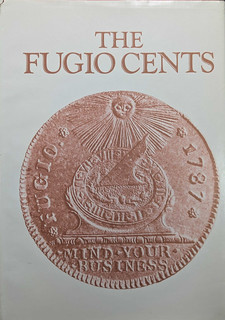 When I originally compiled listings for American Numismatic Biographies, I could not find
information on Alan Kessler, author of The Fugio Cents. Since then, I have gone back several
times looking for information on Kessler. With recent mentions in the E-Sylum, I went back
again this week to check current resources.
When I originally compiled listings for American Numismatic Biographies, I could not find
information on Alan Kessler, author of The Fugio Cents. Since then, I have gone back several
times looking for information on Kessler. With recent mentions in the E-Sylum, I went back
again this week to check current resources.
The book title on the dust jacket, cover and spine is The Fugio Cents. The title page is The Fugio Coppers A Simple Method for Identifying the Varieties with Rarity Listing and Price Guide.
The name of Alan Kessler appears in records for FamilySearch and Findagrave. None of them can be linked to the author. There are 214 citations in the Newman Numismatic Portal. None of these mention his age or provide a middle initial.
A few addresses for Kessler appeared in Coin World.
In 1966, his address was 1105 Lexington Street, Waltham, Massachusetts 02154.
In 1967, his address was 111 Concord Road, Acton, Massachusetts 01720.
Also in 1967-68, his mailing address was Box 57, Bedford, Massachusetts 01730.
In 1970, his mailing address was Box 2012 APO San Francisco, California 96555. In his 1976 book, his address was given as Box 1685 APO San Francisco, California 96555. These addresses indicated that he was serving in the military.
Many men enter military service at age 18 to 20. This is a clue to his age but not proof.
There was no address reported for him before 1966 or after 1976.
Kessler was not listed as a member of the ANA, not listed as a member of any club and not reported to attend any club meeting.
In the book, Kessler listed 25 references. These started with the 1952 article by Eric Newman "Varieties of the Fugio Cent" in Coin Collectors Journal. Fifteen articles from The Colonial Newsletter are mentioned. Other articles mentioned are from Coin Collectors Journal, Coin World, Coins Magazine, Empire Topics and The Numismatist from the 1960's. He did his research from contemporary periodicals and not from historical references. The Kessler book builds on the 1952 Newman article. The Newman files have no correspondence between Kessler and Newman.
The 1950 U. S. Census has 26 listings for Alan Kessler. They include birth years of 1903, 1910, 1920 (2), 1926, 1930, 1933, 1935, 1938, 1939, 1942, 1943 (2), 1945, 1946 (2), 1947 (2), 1948 (2), and 1949 (6). None were residents of Massachusetts at the time of the Census.
In his acknowledgments, Kessler thanks his wife Judy. This led me to an email address. I wrote and Alan Kessler responded saying he was not the author of the book.
The acknowledgements mention Dick August, Tom and Judy Oliver, Jim Spillman and Robert Vlack. Their collections provided illustrations.
The Kessler collection was sold at auction by NASCA on April 28, 1981, just five years after the book was published. The catalog does not include a biography. There is a comment that the collection was formed over more than a decade. That is a short time to build a reference collection.
The collection of a lifetime is usually sold late in life. This is also a clue to his age but not proof.
Is there any E-Sylum reader who remembers Alan Kessler? Can you provide a link to his biography?
Interesting mystery. Can anyone help? -Editor
To read the earlier E-Sylum articles, see:
ABOUT THIS ISSUE: JANUARY 19, 2025
(https://www.coinbooks.org/v28/esylum_v28n03a35.html)
NOTES FROM E-SYLUM READERS: JANUARY 26, 2025 : The Kessler Fugio Cents Book
(https://www.coinbooks.org/v28/esylum_v28n04a12.html)
2025 ANS TRUSTEES' AWARD TO THE NYINC
Here's the press release on the 2025 American Numismatic Society Trustees' Award. -Editor
On January 16, 2025, the Board of Trustees of the American Numismatic Society (ANS) bestowed the 2025 Trustees' Award to the New York International Numismatic Convention (NYINC) at the Society's Annual Gala, held at the Century Association in New York City. The award recognized the NYINC as one of the most significant conventions in the United States for the numismatic community, having brought collectors, dealers, and enthusiasts of world and ancient coins together for more than fifty years, and its longtime support of the Society's mission.
The Society's Annual Gala welcomed 120 guests to celebrate the NYINC and its partnership with the ANS during the successful evening, which raised more than $217,000. ANS Life Fellow Dr. Arnold-Peter Weiss served as the emcee of the evening, and ANS President David Hendin presented the Trustees' Award.
 Throughout its history, the NYINC has hosted charity auctions to benefit many non-profit organizations and has presented
a series of lectures in line with the Society's educational mission. Many of the Society's members and supporters are regular
attendees of the annual convention, which celebrates its 53rd anniversary this year. In his remarks, ANS President David Hendin
noted, "It is my honor to present this award, as the NYINC has been a tremendous facilitator of the international numismatic
community and a great friend to the ANS."
Throughout its history, the NYINC has hosted charity auctions to benefit many non-profit organizations and has presented
a series of lectures in line with the Society's educational mission. Many of the Society's members and supporters are regular
attendees of the annual convention, which celebrates its 53rd anniversary this year. In his remarks, ANS President David Hendin
noted, "It is my honor to present this award, as the NYINC has been a tremendous facilitator of the international numismatic
community and a great friend to the ANS."
The Trustees' Award was established in 2003, and recognizes those who have helped to advance the mission of the Society for the study and appreciation of numismatics. The Annual Gala provides critical support for the Society through proceeds from ticket sales, sponsorships, advertising, and other donations. For more information, visit numismatics.org/trusteesawardwinners/.
The ANS, founded in 1858, is a non-profit organization based in New York dedicated to the study of coins, medals, and all other numismatic objects. The Society has one of the foremost research collections and libraries in numismatics and is among the oldest cultural institutions in the United States.
To read the complete article, see:
ANS Awards the 2025 Trustees' Award to the NYINC
(https://numismatics.org/25gala-pr/)
GERRY FORTIN INTERVIEW, PART FIVE
Greg Bennick's latest interview for the Newman Numismatic Portal is with Liberty Seated dime expert Gerry Fortin. Here's the fifth and final part, where Fortin talks about his decision to sell his collection, his blog, and GFRC Auctions. Be sure to check out Gerry's upcoming auction of his world class Seated dime collection at www.seateddimevarieties.com. -Garrett
GREG BENNICK: Because people wouldn't know that necessarily. So, what was it that made you decide ultimately to sell your collection after working on it for so long?
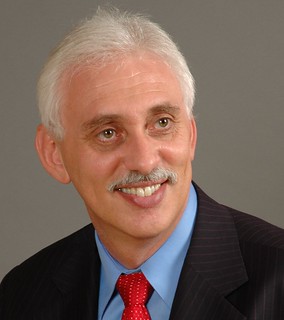 GERRY FORTIN: I tell everybody that the short answer: it was time. Now, what does that mean? Since 2014, I've been selling all my other dimes that were used for the die variety analysis, and I've raised a substantial amount of capital. Well, that capital was going back into my high-end collection. And somehow, I was able, through contacts and through picking spots, I was able to buy some upgrades from the period when Eugene Gardner sold his collection and passed away. So that was 2014. And then we had D.L. Hansen, who kicked in more recently. So, there was a short period in there where I was able to do some more upgrading.
GERRY FORTIN: I tell everybody that the short answer: it was time. Now, what does that mean? Since 2014, I've been selling all my other dimes that were used for the die variety analysis, and I've raised a substantial amount of capital. Well, that capital was going back into my high-end collection. And somehow, I was able, through contacts and through picking spots, I was able to buy some upgrades from the period when Eugene Gardner sold his collection and passed away. So that was 2014. And then we had D.L. Hansen, who kicked in more recently. So, there was a short period in there where I was able to do some more upgrading.
The Tom Bender sale that was held, I think, two years ago, there were some spots in my collection that were weak where I had not allocated monies because they were secondary from an investment perspective. I spent quite a bit of money upgrading that piece of the collection at the Bender sale. And in the past year, essentially, I've liquidated, essentially, all of the dimes through my business. So, my funding source for the collection had dried up.
At the same time, upgrades became ever-increasingly expensive. If you could find them and you could find the right coin, you're talking $15,000 to $40,000 for an upgrade. It's quite hard. And I was not going to take money out of the stock market and other investments to continue this process. I'm not one that's driven by having my pedigree name on a label and being number one on a registry set. That doesn't float my boat. I looked at this as a substantial investment, and I said, it's time. I'm at the point now with GFRC, I started up an auction module a couple of years ago. And who else better to sell the set than me? The gentleman that put it together, I can write my own catalog, do my own photography, market my own collection, and no one will cherry pick me. I know this series quite well.
GREG BENNICK: That's exactly right. You're the proverbial man, as it were, when it comes to Liberty Seated Dimes.
GERRY FORTIN: Right, right. So, you know, it was just that period of my life is coming to an end. And now the monies that are going to be generated are going to be for the next stage of my life. I'm going to move on and do some other things.
GREG BENNICK: I can't wait to find out what that is. That'll be our next interview someday. (both laugh).
So where do you get the inspiration to write your blog every day? There's lots of blogs in the world. There's lots of bloggers. There's lots of people who post on the internet. You post blog posts every single day on your website. It's astounding the amount of content that you put out. Where does that inspiration and motivation come from? It's pretty remarkable.
GERRY FORTIN: You got to remember, I come out of the semiconductor industry. The semiconductor industry: very, very intense. You just can't believe how challenging, how mentally challenging that industry is. You have to deal with all the day-to-day operational issues. At the same time, you have to be looking two steps ahead as the technology changes. So, you're working at one level. And then in six to nine months, you've got a new technology platform coming that you have to learn while you're working all the operational issues on the current platform.
So, I'm a very structured person. And every day when I went into the office, I would sit down and make a list of seven things or ten things I had to get done, or, these are all the hot buttons I have to focus on. Now, when you're running marketing and sales, and you have to keep a Chinese factory full of orders, and you're dealing internationally, there's a lot of stuff going on.
GREG BENNICK: Yeah, for sure.
GERRY FORTIN: So, my mind was just trained. When I started the coin business, I said, "All right, I'm a little guy. How do I make a big splash? How do I compete with much larger entities than me?" And I said, "Well, let's think back in history of what impressed me. And Q. David Bowers used to write The Rare Coin Review.
GREG BENNICK: Loved it!
GERRY FORTIN: It was a phenomenal marketing tool. He had it. And then I'm sure you remember the original JJ Teaparty over in Boston, right?
GREG BENNICK: Of course.
GERRY FORTIN: Well, you know, Liz was the principal, but some others. There was a woman named Gail. Gail and Liz worked together. Gail would send out the price list by email. When she sent out the price list, she lived in Massachusetts, and she always had this beautiful introduction about her garden or the weather, something real folksy. I love reading that. So that stuck with me. Like, all right, I'm going to put together a blog that's like a combination between something folksy, personal, but hardcore coins. That's how the blog was designed. Then I said, I'm going to do it every day because in the semi business, I would do it every day. You know, I would sit down and organize my day.
The blog becomes essentially a diary. That's all it is. It's a personal diary of my life with the folksy stuff. I publish a lot about my John Deere tractor, my twenty-three acres, and the park I'm building in the summer...and then I add the coin piece. I market all the new consigned coins or the coins I buy. People come by, and my readership is like 500, 600 people a day.
GREG BENNICK: That's great. I love the connection to Rare Coin Review. In the other room, I have a nearing complete set, not quite yet, of Rare Coin Review. And I always loved reading those, and American Numismatic Rarities catalogs and all that. There was always a feeling, and you get this from reading your blog as well, of the person behind the coins, not just the coins. And, you know, people say we do business with people we like. We do business with people we know, and reading your blog has that feeling. It's like, "Oh! I see where this guy's coming from." I got that feeling all the time with Dave Bowers and Rare Coin Review.
GERRY FORTIN: Yeah, exactly.
GREG BENNICK: That's great. Well, is there anything that we didn't cover today that you'd like to make sure that we talk about for the next few minutes before we close?
GERRY FORTIN: Oh, wow. So, the front line, so I call it "the front-line set." I think Len Augsburger gave it that name...I'm now in the process of marketing and selling that collection. It's a substantial undertaking. My subsidiary GFRC Online Auctions. I typically sold probably the largest collection I sold was $300,000, maybe $400,000. So, now I am selling two collections, my personal collection, and the personal collection of my top client at the same time. So, I've got $2.5 million of the finest Seated Dimes and the finest Seated Halves that I'm now marketing and selling in the first half of 2025. So, again, it's intense, you know, it doesn't stop.
GREG BENNICK: So, where can people find out about these sales if we're able to get this out, and I hope to in the next little while or so. Where can people find out about these sales, or if after the fact, where can they learn about what was sold and maybe learn more about Seated Dimes as a result of what was sold?
GERRY FORTIN: You just got to go to my website. It is: www.seateddimevarieties.com.
GREG BENNICK: Seateddimevarieties.com. That's great.
GERRY FORTIN: And it's a complete platform. So, you have the original, I call it "web book," that discusses all the Seated Dime Varieties in a fashion similar to Overton. There's an open registry module. Then they have the GFRC sales module. You have a sales archive. So, every coin I've sold since 2014 is available in a sales archive. Pictures, descriptions, prices, the whole bit. So, the complete history of my business over ten, eleven years. And then we have the auction module. So, you go to my website, and then there's just a gray link bar on top, which is like auction and, die varieties and consignments if you want to consign coins, and so on and so forth. You just click on that, and it'll take you into the different subsections of the platform. One of them is the auction module. So, today, those two sets are now listed. Full catalog, pictures, descriptions, reserves. And come January 19th, the first session opens, and bidding will be available.
GREG BENNICK: Fantastic. Well, I hope that viewers go and check out these listings. I'm so excited that I had a chance to talk to you today, Gerry. I really appreciate your time. This has been great. And just thank you very much for being with me today for a few minutes.
GERRY FORTIN: Well, thank you for coordinating this and the chat. I thoroughly enjoyed it, too.
GREG BENNICK: I'm so glad. So, if anybody is interested in seeing other interviews, I've done a full series with prominent numismatists that's available on the Newman Numismatic Portal. And it's also available through the E-Sylum in a print version. So, if you're interested in seeing more, just search those formats, those locations, and you'll certainly find more interviews. Until next time, I'm Greg Bennick, here with Gerry Fortin today. Thanks for being here, everybody, and thank you once again, Gerry.
GERRY FORTIN: All right. My pleasure. Thanks so much.
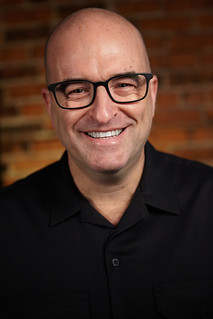 About the Interviewer
About the Interviewer
Greg Bennick (www.gregbennick.com) is a keynote speaker and long time coin collector with a focus on major mint error coins and US counterstamps. He is on the board of both CONECA and TAMS and enjoys having in-depth conversations with prominent numismatists from all areas of the hobby. Have ideas for other interviewees? Contact him anytime on the web or via instagram @minterrors.
To watch the complete video, see:
Gerry Fortin Interviewed for the NNP by Greg Bennick
(https://youtu.be/aNYBgaAxv7k)
To read the complete transcript, see:
Gerry Fortin Interviewed for the NNP by Greg Bennick (Transcript)
(https://nnp.wustl.edu/library/book/643416)
To read the earlier E-Sylum article, see:
GERRY FORTIN INTERVIEW, PART ONE
(https://www.coinbooks.org/v28/esylum_v28n01a13.html)
GERRY FORTIN INTERVIEW, PART TWO
(https://www.coinbooks.org/v28/esylum_v28n02a18.html)
GERRY FORTIN INTERVIEW, PART THREE
(https://www.coinbooks.org/v28/esylum_v28n03a17.html)
GERRY FORTIN INTERVIEW, PART FOUR
(https://www.coinbooks.org/v28/esylum_v28n04a17.html)
CNG TRITON XXVIII AUCTION RESULTS
This press release from Classical Numismatic Group discusses results of their recent Triton XXVIII sale. -Editor
An "Ides of March" silver coin struck by Brutus to celebrate the assassination of Julius Caesar sold for an astounding $551,250, and bidding for an extremely rare and beautiful Greek silver coin of the lost city of Pheneos attained a breathtaking $490,000, as strong demand for rare and important ancient, world and British coins drove prices in Classical Numismatic Group's Triton XXVIII Auction, held live in New York City and online January 14-15, to more than double the $5.1 million presale estimate for the 1154- lot offering.
Two follow-up internet sessions, Triton XXVIII Sessions 5 and 6, held January 22-23 in Lancaster PA, also better than doubled their presale estimates to bring the total, bringing the total two-week haul to $12.25 million. All prices quoted include the 22.5% buyer's premium.
"Across the board, this was one of the most successful auctions in CNG's 50-year history," said David Michaels, CNG's director of consignments and shows. "Not only did the Greek and Roman coins exceed expectations, the prices we achieved for the modern world and British coins were simply jaw-dropping," he noted.
Lot 622, the silver denarius of Brutus, famous betrayer of Julius Caesar, was struck in 42 BC, two years after the assassination of Caesar on March 15, 44 BC, well known as the "Ides of March." The obverse featured a portrait of Brutus wearing a slight beard, while the reverse depicted a liberty cap flanked by two Roman daggers and the legend EID MAR. One of about 100 examples known, the type is widely regarded as the most historically important coin ever struck. The denarius, pedigreed to the "Collection of a Connoisseur Classicist," was purchased by a floor bidder after spirited bidding in the auction room at the Intercontinental Barclay Hotel in New York, and on the internet, more than doubling its presale estimate of $250,000.
Lot 236, a rare silver stater of Pheneos, a small city in central Greece whose exact location is still disputed, was struck between 360 and 340 BC from dies produced by a master artisan. The obverse depicts the goddess Demeter, while the reverse sports a striding figure of Hermes, messenger of the god, cradling a small child identified as the infant Arkas, mythical founder of Arkadia. Other Greek highlights include:
Lot 93, a spectacular silver decadrachm of Syracuse, struck circa 405 BC from dies signed by the master engraver Euainetos, and pedigreed to the famous Gillet Collection. This magnificent coin fetched $232,750.
Lot 387, a gold stater of the Egyptian Pharaoh Nektanebo II, which likewise reached $232,750.
Lot 90, a superb Greek silver tetradrachm of Syracuse from circa 415 BC, attained $122,500.
Lot 355, an extremely rare gold stater of the mysterious Seleukid ruler Andragoras, dating to 285 BC and graded Choice AU by NGC, was bid up to $134,750.
Roman Republican and Imperial coins showed exceptional strength in this Triton, Michaels noted. "Greek coins have been all the rage in collecting circles in recent years, but this time the Romans also proved immensely popular with collectors." Besides the auction-topping Brutus denarius, other Roman highlights included:
Lot 753, a gold aureus of the Emperor Maximianus depicting Hercules on the reverse, which reached $110,250.
Lot 731, a rare gold aureus of the Emperor Geta (one of the emperors seen in the current hit movie Gladiator II), which attained $73,500 versus its presale estimate of $25,000.
Lot 802, a gold tremissis of Romulus Augustus, the short-reigning last Roman Emperor of the West, which was bid up to $79,625.
Modern World coins also showed remarkable strength, highlighted the gem-studded Alexander Christopher Collection of European, Asian and New World coins in outstanding grade. Among the most sought-after pieces were lot 841, a gold 20-leva of Bulgaria dated 1894, which reached an astounding $85,750; lot 862, a Chinese silver dollar of the warlord Yuán Shìkai, graded NGC MS 63, which achieved $82,687, and lot 946, a silver ducatoon of the Dutch East Indies dated 1739, which hit a remarkable $79,625.
The Sidney W. and Kenneth W. Harl Collection of British Hammered Coins, a father-son holding than spanned six decades of diligent collecting, also showed the ongoing demand for high-quality early British coins has not abated. Lot 1053, a rare penny of Edward the Elder, topped the set with a price of $42,875, while lot 1038, a splendid example of the famous "Raven penny" of the Viking ruler Anlaf Gufthfrithsson, attained $27,562.
Triton XXVIII also featured a strong offering of rare World and British medals, including lot 1000, a gorgeous gold medal struck to mark the conclusion of China's bloody Boxer Rebellion, with the flags of the allied nations enameled in color, which reached $122,500; lot 1129, a British gold coronation medal of James II dated 1685, bid up to $42,875, and lot 1002, an apparently unique French gold medal honoring Charles Lindbergh's Atlantic flight of 1927, which attained $30,625.
Concluding the floor session were a group of early manuscripts from the collection of Gerald Francis Borrmann, a globe-trotting engineer whose Greek coin collection also featured strongly in the early going. These included lot 1152, a 1493 edition of the Nuremberg Chronicle, a monumental early illustrated encyclopedia, which achieved $55,125; and lot 1153, a 1609 printing of the Parergon sive Veteris Geographiae Aliquot Tabulae, a hugely important early atlas of the ancient and "modern" worlds, which brought $42,875
These results bode extremely well for CNG's next Feature Auction, CNG 129, scheduled for mid-May 2025, Michaels said. "If you would like to see your coins showcased in this world-class auction, please get in touch with us right away, as the deadline is February 15," he added.
Classical Numismatic Group LLC is the foremost U.S. numismatic firm dealing in Ancient, World and British coinage. For more information about consigning to CNG Feature Auction 129, or to receive a printed catalog of the sale, write to CNG@cngcoins.com or call (717) 390-9194.
ATLAS NUMISMATICS SELECTIONS: FEBRUARY 2, 2025
Atlas Numismatics has updated their website with highlights from our most recent upload of 415 coins, medals, and tokens. Select items are discussed below. -Garrett
1081227 | ROMAN IMPERIAL. Pertinax. (Emperor, January - March 193). Struck 193-194 AD. AV Aureus. NGC Gem MS (Gem Mint State) Strike 5/5 Surface 5/5 Fine Style. Rome. 7.20gm. IMP CAES P HELV PERTIN AVG. Laureate head of Pertinax, right /PROVID - DEOR COS II. Female allegory with right arm raised towards a star, left. Cal.-2389a; RIC-11a; Woodard NC 1957, page 10, 11.
Ex The Lexington Collection of Jonathan K. Kern (Heritage Auction 3032 [10 April 2014], lot 23614, $110,000 hammer), and Ex Harlan J. Berk, Buy or Bid Sale (23 March 1995) Lot 227.
$125,000
To read the complete item description, see:
Gem Mint State Pertinax Aureu
(https://atlasnumismatics.com/1081227/)
1081115 | AUSTRIA. Leopold V & Claudia de' Medici. (Regent of Tyrol, 1632-1646). (1635) ND AR 2 Thalers. PCGS MS62. Hall. 57.13gm. LEOPOLDVS·ARCHID:AVS:ET·CLAVDIA·ARCHIDVCISA·AVS:MEDIC·. Crowned busts facing right of Léopold Archduke of Austria and his wife Claudia de' Medici. / DVX?BVRGVNDIÆ?COMES?TIROLIS:. Crowned Tyrolean eagle within beaded circle; wreath divides legend above. KM 639; Dav.- 3331; M/T 487.
Minted during the regency of Claudia de' Medici during the minority of her son, after the death of Archduke Leopold V death in 1632.
$4,450
To read the complete item description, see:
Appealing Jugate Portrait Double Thaler
(https://atlasnumismatics.com/1081115/)
1081196 | CONGO FREE STATE. Leopold II. (King, 1885-1908). 1896 AR Essai 5 Francs. PCGS SP65. By Fernan Dubois. Edge: Lettered, TRAVAIL ET PROGRES. LEOPOLD II R. D. BELGES... Head left / Crowned arms with supporters within wreath; banner inscribed TRAVAIL ET PROGRES with date below. KM Pn20; Dupriez 91. Currently the sole certified example and finest known at PCGS as of January 2025.
$22,500
To read the complete item description, see:
Essai Congo 5 Francs
(https://atlasnumismatics.com/1081196/)
1080872 | ETHIOPIA. Ras Tafari (Haile Selassie). (Emperor, 1916-1930). EE1921 (1928) AV Medal. PCGS MS61. Addis Ababa mint. 43mm. 39.5gm. Crowned and mantled bust facing towards the left / Airplane, right "Nesra Tafari" in Ahmaric above; date EE 1921 below. Gill RT12. On the Acquisition of Four Airplanes for the Ethiopian Military.
$24,500
To read the complete item description, see:
Rare Medal of Ras Tafari
(https://atlasnumismatics.com/1080872/)
1081198 | FRANCE. 1900-A AV 50 Francs. PCGS PR67 Cameo. Paris. Standing Genius writing the Constitution, rooster at right, fasces at left / Denomination above date within circular wreath. KM 831; Gadoury 1113; Friedberg 591; F.-549. Just 200 examples reportedly struck for this date with a handful of these being proof strikings (likely struck for the 1900 Exposition Universelle and quite possibly struck at the fair itself rather than at the mint).
$189,500
To read the complete item description, see:
Extremely Rare Proof 50 Francs
(https://atlasnumismatics.com/1081198/)
1080960 | GREAT BRITAIN. Victoria. (Queen, 1837-1901). 1838 AV Coronation Medal. PCGS SP61. By B. Pistrucci. Edge: Plain. 36mm. 31.57gm. VICTORIA D.G. BRITANNIARUM REGINA F.D. Bandeau draped bust of Victoria left / ERIMUS TIBI NOBILE REGNUM. Queen enthroned at right being presented crown by Britannia, Hibernia and Scotia at left. Eimer 1315; BHM-1801; Woll.xvii; W&E.88.3; Stef. Vol. I, pl. 32. On the Coronation of Queen Victoria.
To read the complete item description, see:
Gold Victoria Coronation Medal
(https://atlasnumismatics.com/1080960/)
ARCHIVES INTERNATIONAL AUCTION 99 SELECTIONS
Here are some selections from the Archives International sale closing February 5, 2025. -Editor
Lot 113:Ireland, ND (1866-1867). 10 Dollars P-S102r FE7, Remainder Bond, Black on green underprint with portrait of "Wolfe Tone" at lower left and "Davis" at lower right and dramatic eagle on mountain in middle, Back is green, S/N 4276/3276 pp B, PMG graded Choice Uncirculated 64 EPQ, CONB. The Fenian Brotherhood were a committed group of Irish nationalists who attempted an unsuccessful rebellion in the 1860s. Their leaders continued to harass the British for years and help inspire and participate in the eventual successful rebellion against Britain in the early 20th century.
To read the complete lot description, see:
Ireland. Republic of Ireland, ND (1866-1867), Remainder Promissory Bond.
(https://auction.archivesinternational.com/Ireland-Republic-of-Ireland-ND-1866-1867-Remainder-Promissory-Bond_i55369070)
Lot 138: Pretoria, South Africa, 1952. 100 Pounds, P-100a, Issued Banknote, Brown and blue on m/c underprint with portrait of Jan van Riebeeck at left and sailing ship at right, Back Is m/c with arms at center, S/N E/1 019422, PCGS graded Very Fine 30 with comment "Small Edge Tears" and "Minor Stains." Exceptional looking note with large even margins, bright colors, sharp corners and fresh appearance. This note deserves a higher grade designation with only one extremely minor tear on the top left middle that is approximately 2.5 mm long and just touching the design. The minor stains are on the very bottom border and barely visible. The note has minimal folds and appears Choice VF to XF or better and is an exceptional example of this rare note.
To read the complete lot description, see:
South Africa. South African Reserve Bank, 1952, Issued 100 Pounds Banknote Rarity.
(https://auction.archivesinternational.com/South-Africa-South-African-Reserve-Bank-1952-Issued-100-Pounds-Banknote-Rarity_i55369095)
Lot 205: South Carolina, June 1, 1775. £10 SC-99, Issued Banknote, Black printing with seal at right with 'Et Deus Omnipotens' at top, Uniface note, S/N 15068, PCGS graded Very Fine 30 Apparent with comments "Splits, Tears, Minor Edge Damage, and Repairs."
To read the complete lot description, see:
SC. South Carolina Colonial Currency, June 1, 1775. £10 , SC-99, Issued Colonial Note.
(https://auction.archivesinternational.com/SC-South-Carolina-Colonial-Currency-June-1-1775-10-SC-99-Issued-Colonial-Note_i55369162)
Lot 232: Washington, D.C., September 1st, 1852, $5- $10, Haxby DC-350-G6-G8, pp A, Black printing on white thin card mounted on card, POCs, PMG graded Choice Uncirculated 64, DB&Co.
To read the complete lot description, see:
Bank of the Republic, September 1st, 1852, Uncut Proof sheet $5-$10 Pair.
(https://auction.archivesinternational.com/Bank-of-the-Republic-September-1st-1852-Uncut-Proof-sheet-5-10-Pair_i55369189)
Lot 264: Washington, D.C., 1922. $20, P-275, Fr.#1187, Issued Gold Certificate, Black with orange underprint, Portrait of George Washington at center, Back is orange with seal of United States at center, Orange seal at right, Signed by Speelman | White, S/N K46942971 Plate G342/53, Legacy graded Very Fine 25.
To read the complete lot description, see:
Washington, D.C. Gold Certificate, $20, Series of 1922, Fr.#1187, Issued Banknote.
(https://auction.archivesinternational.com/Washington-D-C-Gold-Certificate-20-Series-of-1922-Fr-1187-Issued-Banknote_i55369221)
Lot 285: Malvern, Pennsylvania, 1904. $5 RS, Series of 1902, Ch# 3147, Fr.#587, Lyons | Roberts Signatures, Red seal at bottom right corner, S/N 1567B Plate 60, PCGS graded Very Fine 25 Apparent with comment "Minor Rust Stains." 2 Previous Red Seals known on the bank, this one is new to the census. A $5 Red Seal has not been offered at auction since 2007, where Heritage sold one in lesser condition for $8625.
To read the complete lot description, see:
PA. National Bank of Malvern, Pennsylvania, $5 RS, Series of 1901, Ch# 3147, Issued Banknote.
(https://auction.archivesinternational.com/PA-National-Bank-of-Malvern-Pennsylvania-5-RS-Series-of-1901-Ch-3147-Issued-Banknote_i55369242)
Lot 453: New Jersey, 1887. $1000 Specimen 5% Registered General Mortgage Gold Bond, Black text with green border and underprint, Men loading a ship at top left, Man with an anvil at top right. Red specimen overprints, 00000 serial numbers, and POCs. XF-AU condition, ABNC.
To read the complete lot description, see:
Central Railroad Co. of New Jersey, 1887 Specimen Bond
(https://auction.archivesinternational.com/Central-Railroad-Co-of-New-Jersey-1887-Specimen-Bond_i55369410)
NUMISMATIC AUCTIONS LLC SALE 69
Steve Davis of Numismatic Auctions LLC is holding Sale 69 this month. Here are some selections. -Editor
To read the complete lot description, see:
https://numismaticauctions.nextlot.com/auctions/1704928/lots/37302483
To read the complete lot description, see:
https://numismaticauctions.nextlot.com/auctions/1704928/lots/37302791
To read the complete lot description, see:
https://numismaticauctions.nextlot.com/auctions/1704928/lots/37303428
To read the complete lot description, see:
https://numismaticauctions.nextlot.com/auctions/1704928/lots/37304275
To read the complete lot description, see:
https://numismaticauctions.nextlot.com/auctions/1704939/lots/37304632
To read the complete lot description, see:
https://numismaticauctions.nextlot.com/auctions/1704939/lots/37304821
To read the complete lot description, see:
https://numismaticauctions.nextlot.com/auctions/1704939/lots/37307684
To read the complete lot description, see:
https://numismaticauctions.nextlot.com/auctions/1704939/lots/37308377
US 1942 Gold 2.5oz+ 24K Numerology Masonic Prophetic Magic Square Knights Templar Themed Medal by Albert Wiss. 40mm, 24K(1000 Fine Gold edge hallmark) 79.91g according to NGC, by Albert Wiss. NGC MS63 Top Pop – the finest graded example and the only certified example extant! This highly unusual piece evokes the mystic prophecy themes of the realm of Numerology, Arithmology, Knights Templar, Freemasons, Ouija, Nostradamus, Egyptian Mystics, Kabbalists and the Occult.
The medal exhibits the important pivotal dates of July 4, 1776, as well as the years 1492 & 1861 – all benchmarks in American history, alongside cryptic alphanumeric charts and tables within a Masonic "Magic" square & compass imagery and a Cross/Tree of Life symbol. A fascinating piece with hefty pure gold content.
A similar, yet far lesser grade raw EF, hairlined and spotted example sold as Lot 900 of a May 2023 CNG Sale for 8000 USD hammer plus a BP of 22.5% to 25% with a much lower gold spot of $1971 at the time!
Wiss was a known mathematics genius, revered jeweler and importer of Fine Swiss Watches in NY at the time this medal was made. Rare, Choice and highly unusual! One can envision Nicholas Cage in a film like National Treasure utilizing this intriguing Gold Medallion to predict future events. A large and impressive piece with an intriguing and mysterious history, this being the finest and sole certified/graded example, worthy of a premium bid!
To read the complete lot description, see:
numismaticauctions.nextlot.com/auctions/1704939/lots/37308790
Steve adds:
"There are nearly a dozen Three Legged Nickels and nearly a dozen 1916-D Mercury Dimes, all gleaned from the till by a Federal Reserve Employee in the 1940s -1950s as well as a number of his other early album sets, keys and error coins throughout the sale. The guy paid face value for his entire collection snagged from his time searching coins while working there....nice work if you could get it.
For you bibliophile guys, I will have a neat old run of 25-30 cool box lots of Numismatic Literature from the Myron Xenos Money Tree collection of literature remainders going back to the Ken Lowe/Myron Xenos era. I do not have those lots up online yet, but they will be up by next weekend! Those will close out the Fourth day of the Auction at the end of the sale on Feb 20th. A crazy sale for us with spot this high and nearly 500 gold coins in the sale."
TAYLOR SWIFT'S ANCIENT COIN NECKLACE
You didn't know The E-Sylum had a fashion department, did you? Well, here's something about Taylor Swift's ancient coin necklace. According to People magazine, "The singer's coin necklace left fans in a spiral of speculation". -Editor
Is Taylor Swift teasing fans with her latest fashion accessory?
For the Kansas City Chiefs game in Missouri on Sunday, Jan. 26, the pop songstress, 35, wore what appeared to be a Steven Battelle-designed 18K gold Ancient Greek coin pendant necklace with a diamond accent, according to fashion pro and Swift expert Sarah Chapelle.
Though fans on X thought the singer might be pointing at her re-recorded album, Reputation (Taylor's Version), with the accessory, believing that the coin had intertwining snakes on it like the one seen for sale here on 1stDibs for $3,100, each of Batelle's necklaces is one of a kind, which means Swift's must be a different piece!
 Swift's latest accessory for the AFC championship game was in line with another necklace she wore at the beginning of the season: an antique coin for the Chiefs' first game, where the team also took home a victory against the Ravens.
Swift's latest accessory for the AFC championship game was in line with another necklace she wore at the beginning of the season: an antique coin for the Chiefs' first game, where the team also took home a victory against the Ravens.
Swift supported her boyfriend Travis Kelce at Arrowhead Stadium by pairing the necklace with an outfit inspired by the Chiefs colors.
She arrived at the Chiefs' game on Sunday — which they won 32-29 against the Buffalo Bills advancing to the Super Bowl — with her parents Andrea and Scott and her brother Austin.
The 14-time Grammy winner was later seen kissing Travis, whom she has been dating since 2023, on the field in celebration of his team's win.
To read the complete article, see:
Did Taylor Swift Make Subtle Nod to Reputation (Taylor's Version) with Necklace at Chiefs' AFC Championship Game?
(https://people.com/taylor-swift-reputation-taylor-version-snake-necklace-8780710)
In keeping with tradition, next month's Super Bowl will kick off with a coin toss on the field — and it's a decent bet that up the stands, Taylor Swift will be wearing a coin of her own.
Over the past few months, the Grammy winner-turned-WAG has accessorized a number of her game-day and street style ensembles with jewelry fashioned from ancient currency; some actual antiques, other modern replicas.
Most recently, the "Fortnight" singer selected a silver pendant from Steven Battelle for Sunday night's AFC Championship game.
"The image on that particular pendant is of the goddess Roma," Battelle tells Page Six Style. "She was believed to watch over the city's citizens and protect them from harm, as well as being a fierce defender of Rome in war."
Per the jeweler, the reverse side of the authentic antique coin — struck in 109-108 BC during the Roman Republic — depicts Victoria, the winged Roman goddess of victory.
"There is something almost talismanic about the messages that we try to interpret from those coins," Battelle notes. "To me, someone wearing an ancient coin piece has not only an appreciation the beauty of the ancient images, but an appreciation of the continuity of history and our place within it."
To read the complete article, see:
Taylor Swift's ancient coin jewelry is steeped in symbolism — but what does it mean?
(https://www.yahoo.com/entertainment/taylor-swift-ancient-coin-jewelry-221631693.html)
1793 MANCHESTER PROMISSORY HALFPENNY, PART TWO
Denis Richard of Canada's Coin Photography Studio publishes a blog with some nicely researched (and illustrated!) articles on various numismatic topics. With permission, we're republishing one here. Thank you! Here's the second of two parts of an article on the 1793 Manchester Promissory Halfpenny token. -Editor
Manufacturers like William Lutwyche played a pivotal role in the evolution of token production, broadening its driving forces to 'supply' and 'demand.' This transformation turned tokens into a marketed commodity instead of merely a commissioned item.
Lutwyche aimed at the rural market segment, close to the sources of raw materials or waterpower, concentrating his sales efforts on tradesmen and shopkeepers in provincial areas like Manchester. Perhaps a savvy merchant, John Fielding, might have sought out tokens to boost his business visibility or a travelling salesman from Lutwyche's visited his shop. Birmingham's toy manufacturers, even leading medallion creators such as Matthew Boulton, had long employed travelling salesmen to promote their business, and Lutwyche probably followed a comparable strategy, if more modestly.
According to historical records, this halfpenny token was produced in enormous quantities for its time and place, with a total issuance valued at £2,300. To comprehend the volume of coins this represents, consider that with two halfpence per pence, 12 pence per shilling, and 20 shillings per pound, £2,300 could purchase more than 1.1 million halfpenny tokens. Manchester was home to just 18,560 families, and at a time when people earned only a few shillings per week, this was quite a fortune.
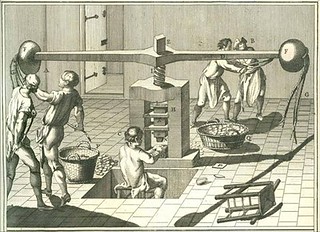 Lutwyche produced a vast array of tokens in relatively limited quantities. Still, his production output of more than 65 tons of "legitimate provincial coins" was surpassed only by Thomas Williams, the consortium of Westwood and Hancock, and Matthew Boulton's Soho Mint. The fact that Lutwyche lacked steam-powered coin presses makes this even more remarkable, meaning a screw press, like the one shown at right, produced the coin featured here.
Lutwyche produced a vast array of tokens in relatively limited quantities. Still, his production output of more than 65 tons of "legitimate provincial coins" was surpassed only by Thomas Williams, the consortium of Westwood and Hancock, and Matthew Boulton's Soho Mint. The fact that Lutwyche lacked steam-powered coin presses makes this even more remarkable, meaning a screw press, like the one shown at right, produced the coin featured here.
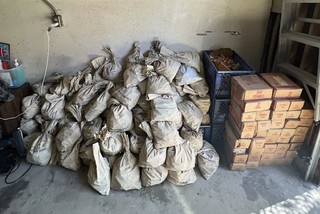 What does a million pennies look like?
What does a million pennies look like?
In Ontario Canada, John Reyes and his wife stumbled upon 1 million copper pennies while cleaning out her father's 1900s-era home.
(photo by John Reyes)
It remains a mystery why Fielding ordered such a large quantity of tokens. The £2,300 cost would be too great for a single shopkeeper. This fact led David W. Dykes, in his book "Coinage and Currency of the Eighteenth-Century – The Provincial Coinage," to propose that Fielding spearheaded a consortium of trade members. This group absorbed the costs, making it more economical to provide tokens for their collective use than it would have been individually.
We may assume Fielding's plan to hand out promissory tokens that could only be used at his store was intended to build customer loyalty and motivate people to come back and buy more. However, the notion of 'promissory' was interpreted quite broadly by numerous issuers, and many viewed issuing tokens mainly as opportunities for speculative gain, content with the idea that once their halfpennies were distributed among the public, they would never have to redeem them. This strategy remains effective today, with up to 10% of gift cards going unredeemed, translating into a profitable revenue stream for businesses.
Today, after 221 years, of the over one million tokens minted, how many remain is anyone's guess. Some undoubtedly lie buried in old gardens and building sites, while others may still be hidden away in collections or treasured by descendants of those who originally received them. Most are likely melted. But many of those that survive in collectors' hands, like the coin pictured here, are well worn, evidence of the extensive circulation they received.
The last interesting feature of this token is it has a die clip or a defective planchet, as seen in the images below. This little nick adds character to the coin, making it slightly less valuable to collectors. Ces't la vie.
The contribution of grocers, often overlooked, played a crucial role in people's daily lives in 18th-century England. This grocer's token has survived over two centuries, outliving its initial use and being passed down through generations. Still, there remain many questions. Who was John Fielding? During his time, seven individuals with the same name were interred in the Manchester area, and it is unclear which one of them issued our token. What drove him to issue these tokens, and how successful was his plan? We'll likely never know the answers, but pondering and exploring the possibilities is fascinating.
I've never enjoyed drinking tea, but I do enjoy having this tea merchant token in my collection.
Denis Richard
 My name is Denis Richard, and I am the eye behind the lens at Coin Photography Studio. I've been making photographs for over two decades and know there are no rules for good coin photographs. There are only good photographs that bring out the best in coins. I create coin portraits because I believe a coin image is more than just a picture; it should be a feeling, and I invite you to experience it with me.
My name is Denis Richard, and I am the eye behind the lens at Coin Photography Studio. I've been making photographs for over two decades and know there are no rules for good coin photographs. There are only good photographs that bring out the best in coins. I create coin portraits because I believe a coin image is more than just a picture; it should be a feeling, and I invite you to experience it with me.
My professional memberships and affiliations include the American Numismatic Association, the Canadian Numismatic Association, the Ontario Numismatic Association, and the Canadian Association of Photographic Arts.
For more information, see:
http://www.coinphotographystudio.com/
To read the complete article, see:
1793 Manchester Promissory Halfpenny
(https://hipshotphotography.com/coin-stories/token-takeover)
To read the earlier E-Sylum article, see:
1793 Manchester Promissory Halfpenny, Part One
(https://www.coinbooks.org/v28/esylum_v28n04a27.html)
COLLECTABLE COUNTERFEIT COINS, PART TWO
Here is the second part of Doug Nyholm's article "Collectable Counterfeit Coins", republished with permission from the Utah Numismatic Society's The Mintmaster. Thank you! -Garrett
Another source of counterfeits are those from China. Up until recently one could purchase Dansco albums from China filled completely with fake coins. Usually these were not the highest quality but were passable. Some of these coins have found their way into the market piecemeal and sometimes are consumed by novice collectors. Although these are not truly collectable counterfeits enough of them wind up in unsuspecting hands that many dealers have bins full of them. Similarly the Chinese seemingly counterfeited just about everything from 1795 dated Trade Dollars to Morgan dollars dated 1877-CC.
One other very collectable counterfeit or "restrike" are those created by Daniel Carr in Colorado. Daniel specializes in striking coins on genuine coin planchets (or overstriking on real coins) those issues that might have existed but for some reason never did. By doing this he avoids any legal issues which would result in striking counterfeits. His coins can only be considered as fantasy pieces such as a 1931-S Standing Liberty Quarter, 1964 Franklin Half Dollar and of course the 1964 Peace Dollar. The 1964 Peace Dollar was actually struck in Denver in 1964 but supposedly all were melted and none exist today. This may or may not be true but according to official government documentation none survived.
I have spoken to several people who have seen one and actually been offered one for sale. However for anyone owning such a coin be advised that if anyone knows about it or or the government hears about it you can certainly expect a visit from the Secret Service at your door. Daniel Carr has literally struck dozens, if not hundreds of fantasy pieces and all are highly collected, some selling for hundreds of dollars. Each has a very limited mintage.
Finally, one additional collectable counterfeit is a series of "Micro O" Morgan silver dollars dated 1896-O, 1900-O and 1902-O Many of these silver dollars were certified by PCGS and other certification services but much later found out to be counterfeits. PCGS made good to the collectors who obtained these fraudulent certified coins who were allowed to return them but some opted to retain these coins and they have been offered as such on the after market by a fairly good sum of money. Even the best collector or service is not perfect.
To read the earlier E-Sylum article, see:
Collectable Counterfeit Coins, Part One
(https://www.coinbooks.org/v28/esylum_v28n04a24.html)
IRAN CONSIDERING CURRENCY REVALUATION
Howard Berlin passed along this article about Iran's plans to revalue its currency. Thanks. -Editor
Iran launched plans to switch its currency to the toman in 2021, replacing the rial by removing four zeros in a bid to mask inflation. But the plan stalled. Now, the government is hoping to revive the effort.
A loaf of bread in Tehran costs 100,000 rials. Or — should it be 10 tomans now? Or 10,000 tomans (roughly $1)?
For ordinary Iranians, a single toman simply means 10 rials. But with the government attempting to streamline currency, even the basic act of buying groceries could soon become a confusing tangle of numbers.
Initially, removing zeros from the currency was aimed to simplify transactions and improve confidence in Iran's financial system.
Proponents argued it would also reduce the psychological impact of inflation. But inflation has not abated, and the public's confidence has continued to erode since 2021.
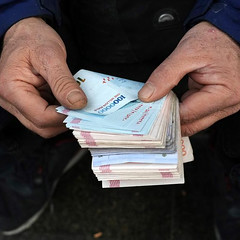 Since the reimposition of US sanctions in 2018, the rial's value has plummeted by more than 80% against the dollar.
Since the reimposition of US sanctions in 2018, the rial's value has plummeted by more than 80% against the dollar.
This devaluation has fueled hyperinflation, with the cost of essential goods like food and medicine doubling in the past year alone. Many Iranians are struggling to meet basic needs as wages fail to keep pace with rising prices.
"Last month, I spent half my salary just on groceries," said Farshid, a Tehran shopkeeper. "It doesn't matter whether it's the rial or the toman — everything is too expensive."
The article goes on to summarize historical currency reform efforts that their success or failure.
Note the halfway measure shown in the above photo - the last four zeroes were printed in paler colors. -Editor
To read the complete article, see:
Toman or rial: Can currency reform stop inflation in Iran?
(https://www.dw.com/en/toman-or-rial-can-currency-reform-stop-inflation-in-iran/a-71470010)
NORTH KOREAN REVALUATION RUMORED
Meanwhile, North Korean citizens are moving to foreign currencies over the domestic won as revaluation rumors abound. Found via News & Notes from the Society of Paper Money Collectors ( Volume X, Number 32, January 21, 2025). -Editor
Amid persistent rumors of currency redenomination, North Koreans are increasingly shunning the domestic won in favor of foreign currencies. This growing distrust is accelerating the economy's dependence on foreign money.
"Rumors about currency redenomination that began last year continue to spread, and more North Koreans are refusing to hold the domestic currency," a source in South Hamgyong province told Daily NK on Thursday.
At marketplaces and shops, customers are noticeably avoiding the won. U.S. dollars and Chinese yuan now dominate transactions, with won-based exchanges becoming increasingly rare. While merchants have long preferred foreign currency due to mistrust in the won, this preference has now reached unprecedented levels.
A veteran vendor in her 50s, who has operated in Hamhung for over two decades, described the situation as unprecedented. "Dollars were always common here, but now the yuan is everywhere too. Vendors resist accepting won, and customers won't even take Korean coins as change from foreign currency transactions. Some vendors struggle to conduct business because they can't make change in foreign coins," the source explained.
This aversion to the won stems largely from the traumatic 2009 currency reform, when the government limited how much old currency families could exchange for new bills, causing widespread financial devastation. Though more than a decade has passed, this memory continues to haunt North Koreans, fueling current fears of another redenomination.
Common sentiments in Hamhung reflect this anxiety: "We're not foolish enough to hold onto domestic currency" and "There's no telling when people will be ruined by another currency redenomination."
To read the complete article, see:
N. Koreans abandon won as currency redenomination fears spread
(https://www.dailynk.com/english/north-koreans-abandon-won-currency-redenomination-fears-spread/)
CHINESE COMPANY PAYS EMPLOYEES IN SCRIP
In the shades-of-coal-company-scrip department, why bother with real cash if you can pay your employees with scrip good only at your own stores? -Editor
A Chinese company has been placed under official investigation after it gave consumer vouchers instead of money as salary to its employees, triggering online backlash.
A person from northeastern China's Jilin province posted that the shopping centre he worked for, Motian Vitality City, gave its staff consumer vouchers as their salary.
Photos posted by the man on a social media platform showed the vouchers with values ranging from 10 to 500 yuan (US$1.4 to US$70).
The man said that other entities owned by the same parent company Dazhong Zhuoyue Holding Group, including real estate, property management and taxi companies, also gave the same vouchers to their employees.
 An instruction from the company indicated that the vouchers can be used to pay property management fees, buy certain properties and parking space owned by the group at a discount price, and goods at another Motian Vitality City mall in their city until the end of this year.
An instruction from the company indicated that the vouchers can be used to pay property management fees, buy certain properties and parking space owned by the group at a discount price, and goods at another Motian Vitality City mall in their city until the end of this year.
A member of staff with the mall told media outlet Chinese Business View that the vouchers could only be used with some shops, mostly restaurants and clothing stores, and they do not give change if the bought item is less than the value of the voucher.
"Many colleagues have mortgages and car loans, and young kids and old parents to support. We are helpless with these vouchers," the poster said.
The company's behaviour sparked outrage on social media.
"Since when can a company issue their own currency? They should be severely punished," one person said.
Also found via News & Notes from the Society of Paper Money Collectors (Volume X, Number 33, January 28, 2025). -Editor
To read the complete article, see:
‘Issue own currency': China firm probed for paying staff consumer vouchers instead of money
(https://www.scmp.com/news/people-culture/trending-china/article/3294022/issue-own-currency-china-firm-probed-paying-staff-consumer-vouchers-instead-money)
LOOSE CHANGE: FEBRUARY 2, 2025
Here are some additional items in the media this week that may be of interest. -Editor
This Greysheet News article discusses the career of commemorative coin innovator Manfred Dunker, who received an award at the World Money Fair 2025 in Berlin. -Editor
Manfred Dunker will forever be known as the foremost innovator of the commemorative coin industry in the 80s, 90s and 00s.
Manfred Dunker was a collector from childhood, collecting stamps and coins. After his time with Dr Oetker, he went on to take charge of the tiny coin unit of Richard Borek, joining in 1985. He had a vision that it could be made into a driving force in coins. He renamed the company to MDM. It did not mean Manfred Dunker Münzenhandel as some suggested, but Münzhandelsgesellschaft Deutsche Münze.
During his time, MDM increased from a small entity to 600 people. Before Manfred joined MDM, commemorative coins were much less common than today. Many European countries issued them only on rare occasions. Manfred Dunker inspired national banks and state mints across the globe to expand their issuance of such coins, both as base metal, silver and gold coins. MDM helped with sales and distribution. Manfred was particularly influential in the development of Olympic coins for events such as Barcelona, Albertville, Lillehammer, Sydney, Torino and Beijing.
To read the complete article, see:
Prize to Manfred Dunker, the Innovator of the Modern Commemorative Coin Market
(https://www.greysheet.com/news/story/prize-to-manfred-dunker-the-innovator-of-the-modern-commemorative-coin-market)
The Newman Numismatic Portal relies greatly on the Internet Archive. This article describes the unique clay sculptures commemorating IA employees. -Editor
The Great Room at the Internet Archive was formerly a church nave, and so it's appropriate that a golden afternoon light glows through its arched windows. On a recent Tuesday, Nuala Creed sits in a pew and contemplates the 175 three-foot-tall ceramic sculptures she has crafted over the past 15 years.
All of the figures represent employees, past and present, of the Internet Archive, a free database and digital library started to catalog books, web pages and "the Internet itself."
A figure in the front row sets a mournful tone: It's the sculpture of Aaron Swartz, a computer programmer and activist for a free and open internet who worked as a developer at the Internet Archive before he died by suicide in January 2013 at his Brooklyn apartment. He was being prosecuted for allegedly downloading millions of academic articles from JSTOR.
Today, "people come here to be photographed with Aaron," Creed said.
To read the complete article, see:
At the Internet Archive, employees stay forever — in clay sculptures
(https://missionlocal.org/2025/01/internet-archive-employees-stay-forever-in-clay-sculptures/)
Len Augsburger passed along this story about a thieving postal worker. -Editor
A former Postal Service worker admitted this week that he stole valuable sports collectibles, including Michael Jordan trading cards, an autographed photo of the tennis star Rafael Nadal and a Mickey Mantle card, while he was working as a sorting clerk at a post office in New Jersey, federal prosecutors said.
The items, collectively estimated to be worth more than $100,000, were taken from parcels destined for an auction house in Clifton, N.J., and sold to individual buyers or sports collectibles stores, prosecutors said.
To read the complete article, see:
Postal Worker Stole Sports Memorabilia Worth $100,000, U.S. Says
(https://www.nytimes.com/2025/01/29/us/usps-employee-guilty-sports-memorabilia-theft.html)
FEATURED WEBSITE: THE PAPER MONEY PROJECT
This week's Featured Website is the Paper Money Project. Found via the February 2025 issue of The Mintmaster from the Utah Numismatic Society. -Editor
The Paper Money Project is an attempt to track many early U.S. Small-Size currency varieties and to share the associated census information with the numismatics community. A smaller version of this census project initially started around 20 years ago by Jamie Yakes and focused on $5 LFBP (Late-Finished Back Plate) #637 & #629 Mules, $5 LFP #307 notes, and a few scarce $5 blocks. After the project went dormant for nearly a decade, I picked up where he left off and expanded the census project to focus on a number of other early U.S. Small-Size varieties such as $20 LFBP #204 FRNs, $10 LFP #86 & #87 Silver Certificates, $5 & $10 Narrow Face FRNs, etc.
While this project is starting off as a party of one, my desire is to collaborate with other collectors and numismatists who also find joy and a sense of intrigue in this type of project. I'm open to working with just about anyone who wants to share data, join the project, or help out in other ways. If you'd like to join me on this journey or potentially host a census project on this site, please feel free to reach out to me.
https://www.papermoneyproject.com/
ABOUT THIS ISSUE: FEBRUARY 2, 2025
My E-Sylum work is usually crammed into the weekend, and this week Saturday was particularly unproductive, but that's OK. I was handling chores such as dealing with a security system technician and doing laundry, and pleasant outings such as dinner with family and a stop at the International Bond and Share Society show in nearby Herndon, VA. More on that next week. As always, the issue somehow came together, and many thanks to Garrett Ziss, whose assistance relieves some of the weekly deadline pressure - he handled five of the articles in the issue. -Editor
Wayne Homren
Wayne Homren is the founding editor of The E-Sylum and a consultant for the Newman Numismatic Portal. His collecting interests at various times included U.S. Encased Postage Stamps, merchant counterstamps, Pittsburgh Obsolete paper money, Civil War tokens and scrip, Carnegie Hero Medals, charge coins and numismatic literature. He also collects and has given presentations on the work of Money Artist J.S.G. Boggs. In the non-numismatic world he's worked in artificial intelligence, data science, and as a Program Manager for the U.S. Department of Defense.
Garrett Ziss
Garrett Ziss is a numismatic collector and researcher, with a focus on American paper money and early U.S. silver and copper coins. He is also a part-time U.S. coin cataloger for Heritage Auctions. Garrett assists Editor Wayne Homren by editing and formatting a selection of articles and images each week. When he's not engaged in numismatics, Garrett is a Senior Honors student at the University of Pittsburgh.
Pete Smith
Numismatic researcher and author Pete Smith of Minnesota has written about early American coppers, Vermont coinage, numismatic literature, tokens and medals, the history of the U.S. Mint and much more. Author of American Numismatic Biographies, he contributes original articles to The E-Sylum often highlighting interesting figures in American numismatic history.
Greg Bennick
Greg Bennick (www.gregbennick.com) is a keynote speaker and long time coin collector with a focus on major mint error coins and US counterstamps. He is on the board of both CONECA and TAMS and enjoys having in-depth conversations with prominent numismatists from all areas of the hobby. Have ideas for other interviewees? Contact him anytime on the web or via instagram
@minterrors.
John Nebel
Numismatist, photographer, and ANS Board member and Fellow John Nebel of Boulder, CO helped the ANA and other clubs like NBS get online in the early days of the internet, hosting websites gratis through his Computer Systems Design Co. To this day he hosts some 50 ANA member club sites along with our
coinbooks.org site, making the club and our E-Sylum archive available to collectors and researchers worldwide.
Bruce Perdue
Encased coinage collector (encasedcoins.info) Bruce Perdue of Aurora, Illinois has been the volunteer NBS webmaster from its early days and works each week to add the latest E-Sylum issue to our archive and send out the email announcement.

